Queens Borough in New York City is known as “The World’s Borough” for a reason: what happens on Roosevelt Avenue has ripple effects near and far.
In this vibrant borough there is a street called Roosevelt Avenue that cuts a cross-section through some of the most ethnically diverse neighborhoods on Earth. Spanish, Bengali, Punjabi, Mixtec, Seke, and Kuranko are among the hundreds of languages spoken here. Nepalese dumplings and Korean noodles, Mexican tortas and Colombian empanadas, Thai curries and spicy South Indian vindaloos are just some of the many food choices.
Passing from one block to the next—through neighborhoods including Elmhurst, Corona, and Jackson Heights—can feel like crossing continents. Plazas and parks are crowded with vendors selling tamales, atole, and large-kernel corn. Tibetan Buddhists, fluent in the Indigenous languages of the Himalayas, walk to worship in their red-and-orange robes. Bangladeshi curbside markets teem with overflowing crates of ginger, garlic and humongous jackfruits, picked out by people wearing saris and shalwar kameez.
Growing up in New York, my own family would come to Queens to watch World Cup matches in South American cafés, just as our abuelos would visit their trusted Argentine butcher for fresh cuts of meat, and our Bukharan Jewish neighbors would come to pray, and our Indian family friends would come shopping for amulets and syrup-drizzled sweets for celebrations, all within this same 10-square-mile stretch of city.
Roosevelt Avenue is a pulsing artery of commerce and life. The road itself is chaotic, dark, and loud. You know you’re on Roosevelt because the elevated 7 train runs overhead, the tracks draping it in slitted shadows, and when the 7 train thunders past, for a moment, the frenzied thoroughfare is consumed: older women look up from their pushcarts; chatting friends fall silent mid-speak; and children cover their ears.
Above the storefronts, at the level of the train, are smaller brick offices with signs that reveal the more pressing needs of such a migrant-rich community: “Sherpa Employment Agency,” “Construction Safety Training,” “Irma Travel: Send Money and Shipments to Lima and Provinces.” Taped to the metal pilings and lampposts are hand-written listings with tear-off phone numbers, mainly in Spanish, advertising “rooms for rent,” “employment needed,” and “help wanted.”
Road signs welcome drivers entering Queens to “The World’s Borough.” But there is another phrase that might be more apt: “Queens, Center of the World.” That’s because what happens on these streets has ripple effects near and far, sometimes as far as on the other side of the globe—and what happens on the other side of the globe also certainly influences who ends up here. Perhaps at no other point has this been more urgently felt than during the fallout from the COVID-19 pandemic.
In the spring of 2020, the virus ravaged this part of the city. Most people who live here are essential workers who cannot work from home—restaurant cooks, delivery workers, cab drivers, construction builders—and many live in overcrowded quarters, so the disease spread precipitously. Elmhurst Hospital, which serves this community, was declared the “epicenter of the epicenter” for the initial outbreak in the U.S.
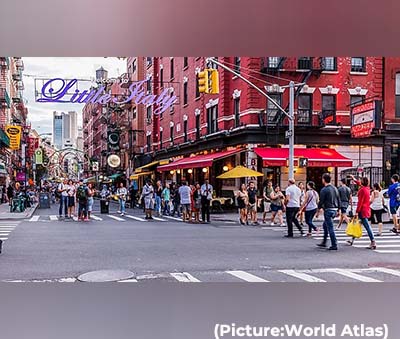 In New York, such a rapid and large-scale loss of life meant that the city’s engine sputtered to an even more devastating halt; in other places, like Mexico and Ecuador, Bangladesh and Nepal, it meant that many families could no longer rely on support from relatives in Queens who were suddenly out of work, or worse. Joblessness and hunger skyrocketed, residents just barely getting by. And yet only for a very short while did walking Roosevelt and its surrounding streets have the same eerie, empty feel as in the rest of the city. Its communities and micro-economies, heavily reliant on in-person interactions, cannot afford to stay still.
In New York, such a rapid and large-scale loss of life meant that the city’s engine sputtered to an even more devastating halt; in other places, like Mexico and Ecuador, Bangladesh and Nepal, it meant that many families could no longer rely on support from relatives in Queens who were suddenly out of work, or worse. Joblessness and hunger skyrocketed, residents just barely getting by. And yet only for a very short while did walking Roosevelt and its surrounding streets have the same eerie, empty feel as in the rest of the city. Its communities and micro-economies, heavily reliant on in-person interactions, cannot afford to stay still.
“The people who come over, they come to help their family,” says Sanwar Shamal, of Bengali Money Transfer in Jackson Heights.
Snippets of South Asia
Around the 74th Street subway station, the neighborhood is heavily South Asian—mostly people of Bangladeshi, Indian, and Nepalese origin. Bengali-speaking men wearing skullcaps sell plush prayer rugs, headscarves, and gold-plated Islamic iconography from milk crates on the sidewalks, cigarette smoke pouring out of their mouths as they talk. Mannequins showcase bright-colored salwars and chaniya cholis through tall glass windows, and restaurants serve curries with rice and water in silver bowls and cold metal cups.
Seemingly everywhere in Roosevelt’s path, there is a heightened sense of the “old country”—of memories that haven’t faded over long stretches of distance and time. You feel it in the money-transfer and international courier stores along Diversity Plaza, where people line up patiently to send remittances and packages to relatives back home, relatives they haven’t seen in years and might not ever see again. You feel it on the weekends, when families drive in from all over to shop for groceries at Patel Brothers, or to eat at Samudra or Dera or the famous Jackson Diner. You feel it at the sweet shops, where grandfathers wearing tweed suits and large wristwatches take their smiling grandchildren for treats.
And you certainly feel it when you step into the United Sherpa Association, a former Lutheran Church that in 1996 was converted into a Tibetan Buddhist temple and community center now serving more than 12,000 Himalayan Sherpas, the largest population living outside Nepal. People come here to pray and to drink salty yak-butter tea poured from tall thermoses into bowls of blue-and-white china. In pre-pandemic times—according to Tshering Sherpa, the president of the association—nearly 100 people would fill two floors in this temple to worship. “You could hear the chanting from Broadway,” she says, beaming.
“Our seniors established this United Sherpa Association,” says Temba Sherpa, the group’s vice president, “to protect and maintain our identity.” The Sherpa are a Tibetan ethnic group who for hundreds of years have made their livelihoods in the Himalayas, raising yaks and high-altitude crops in the remote mountains. Practically no one knows the Himalayas better than the Sherpa, and in recent years they’ve also become synonymous with their work as climbing guides and porters on Mount Everest.
“We got our identity and economic benefit from mountaineering,” says Ang Tshering Sherpa, himself a former trekking guide. “But there’s not much of an alternative if you aren’t educated.”
Climbing is often a perilous endeavor for the Sherpa, especially with little in the way of formalized protections from the turbulent Nepalese government. “Going to the mountains, it’s like going to war,” Ang Tshering says. “You don’t know if you’ll come back.” Many hundreds of Sherpa people have died or been seriously disabled on climbs over the years. “Once a Sherpa gets in a kind of accident, the family gets very little, they don’t have a safety net,” Ang Tshering adds.
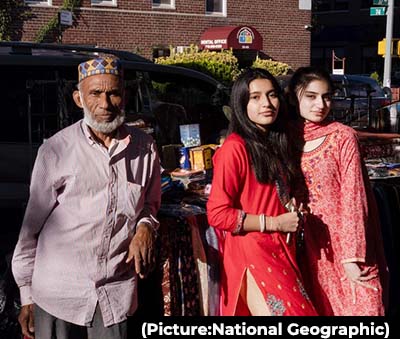 Since the 1990s, and especially after major climbing disasters on Everest, Sherpa have left Nepal in large numbers. Many have come to the area around Roosevelt Avenue, where they often work as taxi drivers, or restaurant cooks and supermarket employees. The United Sherpa Association is a central meeting point of worship and community—where people chant and pray, gather for meals of dhal and root-vegetable stews, and share opportunities for work or study.
Since the 1990s, and especially after major climbing disasters on Everest, Sherpa have left Nepal in large numbers. Many have come to the area around Roosevelt Avenue, where they often work as taxi drivers, or restaurant cooks and supermarket employees. The United Sherpa Association is a central meeting point of worship and community—where people chant and pray, gather for meals of dhal and root-vegetable stews, and share opportunities for work or study.
There are also classes to teach the Sherpa language and traditions to new generations born in the U.S. Shortly after the pandemic began, the association opened a food pantry—available not only to Sherpas but to anyone—and every Tuesday since then, people have lined up in need. And the Sherpas haven’t stopped advocating for their family members back in Nepal, either: for better educational and economic opportunities, and for improved safety infrastructure for climbing guides and porters, especially as recent tourism downturns and pandemic outbreaks have further devastated the country.
“Most of the Sherpa over here, their families are still in Nepal,” says Pasang Sherpa, president of the US-Nepal Climbers Association, a Queens-based nonprofit. “We know exactly who needs help.”
‘La Roosevelt’
Down the road, the sound of spoken Spanish envelops either side of what’s known as ‘La Roosevelt.’ In Jackson Heights there is a block nicknamed ‘Calle Colombia’ (Colombia Street)—where vendors slice cold coconuts with machetes, and tall stalks of sugarcane disappear into juicers for the sweet drink called guarapo. Further east are standing-room-only taquerias, stores bursting with knock-off soccer jerseys, and electronics dealers and barber shops with hawkers outside telling passersby to come in, just for a minute, just to take a look.
On 80th Street, just south of Roosevelt in Elmhurst, Barco de Papel (Paper Boat) stands as the sole Spanish-language bookstore left in New York City. One of the owners is an older Cuban man named Ramón Caraballo who can usually be found there smoking a cigar. He speaks softly and sparingly. “I am just a man who opens up a bookstore in the morning and closes it at night,” Caraballo said when he first introduced himself. “That is all.”
The building is small, just one room, but it is filled from floor to ceiling with a large selection of some of Latin America’s finest writers—Jorge Luis Borges, Gabriel García Márquez, Isabel Allende—as well as lesser-known staff favorites. It is so stuffed with books only its keepers know where anything is to be found.
Caraballo is one of those keepers. Before he co-founded Barco de Papel in 2003, he sold books from a street cart around the corner. “All my life I’ve dedicated myself to literature,” he says. When he opened the nonprofit store—around the same time that Amazon and rising rents began to spell the demise of independent bookstores, especially Spanish-language ones, across the U.S.—it quickly became a community treasure.
Many customers come to Barco de Papel hoping to rebuild the libraries they left behind when they migrated. “They bring their kids, too,” says Paula Ortiz, a high school teacher from Colombia who co-founded the store. “They can’t take them to their countries, so they bring them here.” Others will gather for tertulias—discussions about literature and current events—and live readings.
But Barco de Papel has also become a hub for information. Since the pandemic, many customers leave with information on vaccines, testing, or treatment. New migrants seek out guidance on how to start a small business or learn English. Children whose parents can’t afford to buy another book benefit from book exchanges.
“We have to constantly change with the community, without losing our essence,” Ortiz says. “We owe ourselves to them.”
Corona Plaza
One afternoon in Barco de Papel, I found Caraballo and two helpers unwrapping a large painting that they were planning to put up in a nearby underpass, part of a public art installation in homage to the neighborhood. This one was a bright-colored portrait of a Latina street vendor flanked by a food truck and some ears of large-kernel corn.
Street vending has long been woven into the fabric of Queens, where on the sidewalks you can buy just about anything. In largely Chinese and Korean neighborhoods like Flushing, vendors pull steaming dumplings and salted duck eggs out of steel tubs; plastic bins offer spiced watermelon seeds, eyebrow beans, and goji berry soup. Along Roosevelt, Bangladeshis and Afghans peddling religious items cross paths with Spanish-speaking vendors who sell food and drink, small metal lockets and neon construction vests, disposable masks, rat poison, smartphone cases, and flowered hanging plants.
Some have been selling for years. Many others have only recently begun, after losing their jobs because of the pandemic-induced economic crisis. Pop-up stands of folding tables and tents have appeared (and expanded) on much-transited corners. People walk past with strollers, pulling back the top to reveal not children but candies, popsicles, and sandwiches. Women weave their way through traffic carrying months-old babies in slings on their backs, selling sliced fruit to drivers at red lights.
“Vending has always been big along Roosevelt, especially in Jackson Heights and Corona, but even more so now, because so many people have lost their income, are facing eviction, and have no safety net,” says Carina Kaufman-Gutierrez, deputy director of The Street Vendor Project, a nonprofit that works with street-sellers across New York City. “Every type of relief that came out during the pandemic excluded undocumented folks. And that hit the area so especially hard.”
The Street Vendor Project estimates that during the pandemic, the number of vendors in Corona Plaza, along Roosevelt Avenue at 103rd Street, rose nearly fourfold, from 20-30 people to more than 100. They come prepared for the elements—with tents, tarps, umbrellas and plastic garbage bags—and work through the rain, snow, sun, and cold.
“We used to live in the mountains, my family,” says María Lucrecia Armira, 44, who migrated to Queens in 2019 from a small village in the department of Suchitepéquez, Guatemala. She has had to adjust to spending nearly every waking hour in the smoky heat of a grill stand, selling meat skewers on the loudest corner of the Plaza. Armira arrived two years ago with her 14-year-old son, who enrolled in the local public school; when the pandemic began a short time later, he dropped out and started working full-time selling raspados (shaved ice) and slushies.
“On the one hand I was nervous about the virus,” Armira says. “On the other hand, we were locked down and couldn’t work.” Sharing a single bedroom with her son in an apartment filled with other families, she tries to send $500 per month—or whatever she can—to her two other children, whom she had to leave behind in Guatemala. “Many people count on what we send from here.”
Street vendors now face opposition from brick-and-mortar business owners frustrated with the sudden boom in new and seemingly unlimited competition. In recent months, the city has stepped up its enforcement of street-vending laws, ticketing and removing those without a permit. There are more than 20,000 vendors estimated to be working in the city, and just a small fraction of permits, leading to price-gauging, according to labor activists.
One afternoon on Corona Plaza, the presence of two New York City inspectors sent many vendors scurrying. There were fewer produce-sellers on the sidewalk, food trucks were shuttered, and shopping carts stood empty, piled atop each other beneath the train tracks.
Ana Maldonado stood nervously in the shadows—across the street from her usual spot on the plaza, where for more than 15 years she’s sold tamales and rice pudding and syrupy Mexican-style hot chocolate from a cart of metal vats and orange Gatorade thermoses.
“My customers know me, they know where to find me,” she says, looking out for inspectors from the stairs to the train. The inspectors had warned her to leave, or risk an expensive fine and all of her merchandise being tossed to the trash. “They’re in the middle of the plaza. If they catch me, I’m finished.”
Originally from a small mountain town in Guerrero, Mexico—where, in the green hills, steam rises from rivers swelled with rain—now she wakes up each morning at 4 a.m. and prepares the day’s food for sale on Roosevelt, not returning home until she’s sold everything. Her husband spent 28 days in the hospital with COVID-19 at the start of 2020 and nearly died; he has been unemployed since. “All that my family has, everything comes from this,” Maldonado says. “I work hard to feed them, whatever it takes.”
Queens Globe
As Roosevelt Avenue nears the end of its eastward course, it’s fitting that it passes by the famous Unisphere, the Queens Globe built for the 1964 World’s Fair, that has since become a symbol of this area’s epic cultural diversity. Here in Flushing Meadows-Corona Park, the hustling chaos of Roosevelt Avenue abates, if only for a moment, and the world’s borough comes outside to decompress.
In springtime, families take pictures at golden hour in their best sunshine saris, their favorite skirts and collared shirts in front of an explosion of color: the cornelian cherries, the flowering pears, the forsythia and the redbuds in full bloom. Two years after the onset of the pandemic, despite all the challenges the coronavirus has left behind, there are signs of renewal, too—of soccer games returning to dusty fields with goals carried on backs and bicycles; of misting fountains, and the smell of new grass; of the sound of Mister Softee trucks offering ice cream to children with outstretched arms.
I have often thought about what it means to be American on my walks along Roosevelt—what it means to be the product of so many different stories and struggles and heritages that have led us to one singular, raucous mix of a place. In this country that so deeply strives for assimilation, there is often pressure to distill identities, to make them more palatable for others looking on.
But what is both so special and so hard about Queens is that assimilation does not come easy.
I think about this with every scene that crosses my gaze, with every encounter and conversation—whether in a bookstore or a temple, on the 7 train or on a soccer field in the park. I think about the many definitions of “American” when my own family, a blend of cultures shaped by migrations forced and voluntary, ventures out to this neighborhood for tastes of a past that continues to mark our future here. As parents look for fair and just opportunities to raise their children in the U.S., to learn English, to find work, and to support their families abroad, that sense of the ‘old country’ is unlikely to fade from Roosevelt Avenue, so long as people keep migrating to neighborhoods like this one.
I thought about that when I first met Maldonado, the undocumented street vendor who left Mexico two decades ago and cannot return without risk of not being able to get back into the U.S. I told her that I’d recently been there and asked her what part of the country she was from. Instead of answering right away she touched my wrist with her hands and looked into my eyes. “Cómo está?” she asked about her homeland. “How is it?”

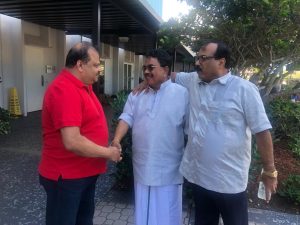 An accomplished organizer, outstanding businessman, journalist and political activist, Dr. Babu Stephen is quite well-known among the Indian American community for his social volunteering activities and organizational abilities.
An accomplished organizer, outstanding businessman, journalist and political activist, Dr. Babu Stephen is quite well-known among the Indian American community for his social volunteering activities and organizational abilities. 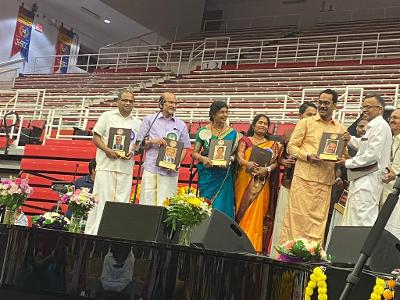 During the solemn ceremony attended by community leaders, diplomats, political leaders and hundreds of community members, including the President of FeTNA V. Caldwell, President-elect Bala Swaminathan, NYTS President Ram Mohan, NYTS leaders Ranga Purushothaman, K Kumaraja, The SA Times-Person of the year 2020 Ravi Bhooplapur, Eric Kumar, Anusuya, Amudha, and Anand Poola along with Nimmi and Kamlesh Mehta on the glittering stage of St. John’s University. The guest also includes Members of Parliament in India from Tamil Nadu. Over 1700 delegates attended the convention.
During the solemn ceremony attended by community leaders, diplomats, political leaders and hundreds of community members, including the President of FeTNA V. Caldwell, President-elect Bala Swaminathan, NYTS President Ram Mohan, NYTS leaders Ranga Purushothaman, K Kumaraja, The SA Times-Person of the year 2020 Ravi Bhooplapur, Eric Kumar, Anusuya, Amudha, and Anand Poola along with Nimmi and Kamlesh Mehta on the glittering stage of St. John’s University. The guest also includes Members of Parliament in India from Tamil Nadu. Over 1700 delegates attended the convention.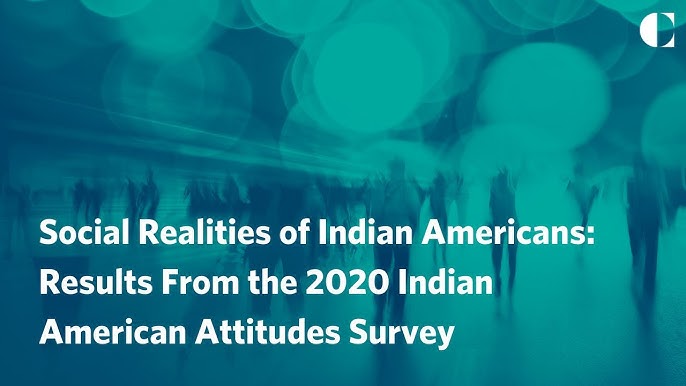 While some in the media interpreted Biden’s off-the-cuff remark as an unfortunate gaffe, others viewed it as affirmation of the growing influence of the Indian American diaspora. In the same exchange, Biden later added: “One of the reasons why we’re such an incredible country is we’re such a diverse country. We bring the best out of every single solitary culture in the world here in the United States of America, and we give people an opportunity to let their dreams run forward.”
While some in the media interpreted Biden’s off-the-cuff remark as an unfortunate gaffe, others viewed it as affirmation of the growing influence of the Indian American diaspora. In the same exchange, Biden later added: “One of the reasons why we’re such an incredible country is we’re such a diverse country. We bring the best out of every single solitary culture in the world here in the United States of America, and we give people an opportunity to let their dreams run forward.”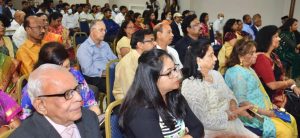 The event was organized by the Federation of Indian American Christian Organizations of North America (FIACONA), a forum of Christian organizations in response to the insidious attempts to alienate and attach the Christians through the propaganda that the Christian faith was left behind by British colonialism in India, despite its two thousand years of tradition.
The event was organized by the Federation of Indian American Christian Organizations of North America (FIACONA), a forum of Christian organizations in response to the insidious attempts to alienate and attach the Christians through the propaganda that the Christian faith was left behind by British colonialism in India, despite its two thousand years of tradition.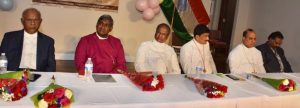 Fiacona President Koshy George pointed out in his welcome speech that our established belief is that Saint Thomas has brought the gospel to India and was martyred in AD 72. To mark its 1900 years, the government of India issued a postage stamp in 1972. So this year marks the 1950th anniversary of the martyrdom of Saint Thomas. Mr. Koshy also expressed his deep concern on the growing persecution of Christians in India as the fundamental religious freedom guaranteed under India’s constitution is no longer guaranteed under the BJP rule under the Indian Courts’ eyes. Last year alone 761 cases of persecution have been identified which have been published in a book form by FIACONA. He said that the purpose of the meeting is to express our pain against such atrocities.
Fiacona President Koshy George pointed out in his welcome speech that our established belief is that Saint Thomas has brought the gospel to India and was martyred in AD 72. To mark its 1900 years, the government of India issued a postage stamp in 1972. So this year marks the 1950th anniversary of the martyrdom of Saint Thomas. Mr. Koshy also expressed his deep concern on the growing persecution of Christians in India as the fundamental religious freedom guaranteed under India’s constitution is no longer guaranteed under the BJP rule under the Indian Courts’ eyes. Last year alone 761 cases of persecution have been identified which have been published in a book form by FIACONA. He said that the purpose of the meeting is to express our pain against such atrocities.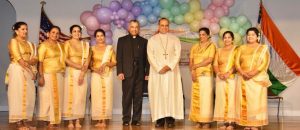 Rt. Rev. Dr. Dharmaraj Rasalam, the Moderator of the Church of South India, spoke about how the arrival of St. Thomas not only impacted the lives of Christians and paid tribute to the sacrifices of the Christian community to the nation in uplifting the poor and oppressed. Rev. Dr. Ruben Mark, the Deputy moderator Bishop spoke about the love Indian Christians in the Diaspora have for India and encouraged them to continue with the unity they have exhibited at the gathering. He described how the arrival and activities of St. Thomas influenced India. The works of St. Thomas is crucial in the Christian faith. He also extolled the diaspora’s love for India. He said that we are proud to be Indian Christians. He said the willingness to sacrifice for the faith was part of the Christian faith. Despite being a persecuted community, Christians are not united. But today, all the sects of Christians are happy to attend this event.
Rt. Rev. Dr. Dharmaraj Rasalam, the Moderator of the Church of South India, spoke about how the arrival of St. Thomas not only impacted the lives of Christians and paid tribute to the sacrifices of the Christian community to the nation in uplifting the poor and oppressed. Rev. Dr. Ruben Mark, the Deputy moderator Bishop spoke about the love Indian Christians in the Diaspora have for India and encouraged them to continue with the unity they have exhibited at the gathering. He described how the arrival and activities of St. Thomas influenced India. The works of St. Thomas is crucial in the Christian faith. He also extolled the diaspora’s love for India. He said that we are proud to be Indian Christians. He said the willingness to sacrifice for the faith was part of the Christian faith. Despite being a persecuted community, Christians are not united. But today, all the sects of Christians are happy to attend this event.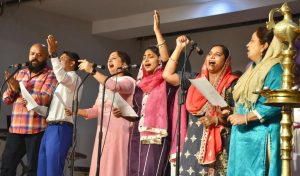 Bishop Johncy Itty, Bishop of the Episcopal Church in Long Island, New York, said that India, along with the rest of the world, is going through a serious crisis today. However, our faith should sustain us in such a time as this. He pointed out that India and the world are in various conflicts. There is no time in life without conflict. But now it is too much. But God leads us by the hand. We may not be able to change the times, but we can make changes.
Bishop Johncy Itty, Bishop of the Episcopal Church in Long Island, New York, said that India, along with the rest of the world, is going through a serious crisis today. However, our faith should sustain us in such a time as this. He pointed out that India and the world are in various conflicts. There is no time in life without conflict. But now it is too much. But God leads us by the hand. We may not be able to change the times, but we can make changes.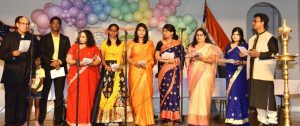 CSI Church General Secretary Adv. Fernandez Rathinaraja pointed to Saint Thomas as a social reformer. It was work against human sacrifice and caste system that led to his martyrdom. Secularism is enshrined In the preamble of the Indian Constitution. There have been concerted efforts to undermine it. Religion should not be a part of political life. The state should be neutral in religious matters. Protests against these are taking place in the states of Tamil Nadu, Andhra and Kerala. He pointed out that the administration is able to suppress the voice of protest in other states.
CSI Church General Secretary Adv. Fernandez Rathinaraja pointed to Saint Thomas as a social reformer. It was work against human sacrifice and caste system that led to his martyrdom. Secularism is enshrined In the preamble of the Indian Constitution. There have been concerted efforts to undermine it. Religion should not be a part of political life. The state should be neutral in religious matters. Protests against these are taking place in the states of Tamil Nadu, Andhra and Kerala. He pointed out that the administration is able to suppress the voice of protest in other states.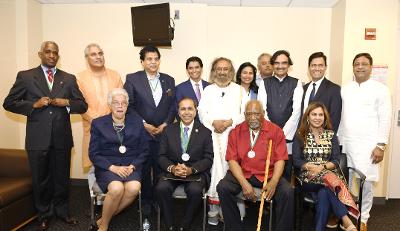 Amidst the series of remarks, State Representative Jim Durkin (R,82nd District) said that he would table a resolution on the floor of the Illinois General Assembly to declare June 26th as the World Peace Day and celebrate its observance in the State of Illinois every year – which elicited sustained applause. Mayor Lori Lightfoot also sent a proclamation to the event, which was read by Alderman David Moore in which she declared June 26 each year to be “I Stand for Peace” Day.
Amidst the series of remarks, State Representative Jim Durkin (R,82nd District) said that he would table a resolution on the floor of the Illinois General Assembly to declare June 26th as the World Peace Day and celebrate its observance in the State of Illinois every year – which elicited sustained applause. Mayor Lori Lightfoot also sent a proclamation to the event, which was read by Alderman David Moore in which she declared June 26 each year to be “I Stand for Peace” Day.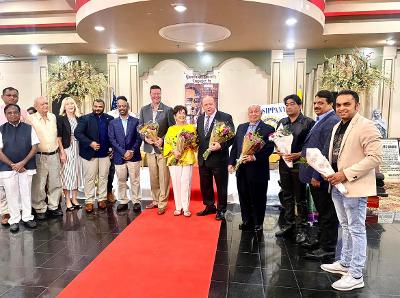 The event started with the singing of National Anthem’s for USA and India and continues with Devotional Songs that Mahatma Gandhi used to have during his prayer meetings. The religious leaders from many diverse faiths like Christianism, Hindu (Iskon) Islam, Jewish (Hebrew), Jain, BAHA’i and many faiths prayed for peace, understanding and making the world a better place.
The event started with the singing of National Anthem’s for USA and India and continues with Devotional Songs that Mahatma Gandhi used to have during his prayer meetings. The religious leaders from many diverse faiths like Christianism, Hindu (Iskon) Islam, Jewish (Hebrew), Jain, BAHA’i and many faiths prayed for peace, understanding and making the world a better place.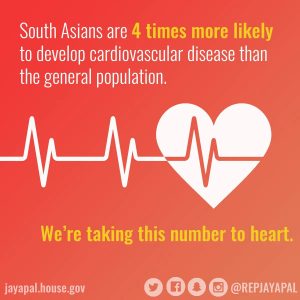 Heart disease is the number one Global Public Health problem. South Asians are at a four-times greater risk of heart disease than their western counterparts and have a greater chance of having a heart attack before 50 years of age, says a . Heart attacks strike South Asian Men and Women at younger ages, and as a result, both morbidity and mortality are higher among them compared to any other ethnic group. They tend to develop heart disease ten years earlier than other groups.”
Heart disease is the number one Global Public Health problem. South Asians are at a four-times greater risk of heart disease than their western counterparts and have a greater chance of having a heart attack before 50 years of age, says a . Heart attacks strike South Asian Men and Women at younger ages, and as a result, both morbidity and mortality are higher among them compared to any other ethnic group. They tend to develop heart disease ten years earlier than other groups.” 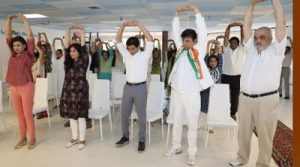 GOPIO-Manhattan Secretary Bhavya Gupta was the MC for the event which was hosted in the presence of Dr. Thomas Abraham, Chairman of GOPIO International as well as distinguished members of GOPIO International and its chapter officials from the Northeast of USA and many viewers from all over the world. The event was also supported by The Indian Panorama, Indian American Forum, GOPIO Chapters (New York, Central New York, Central Jersey, Edison and Connecticut).
GOPIO-Manhattan Secretary Bhavya Gupta was the MC for the event which was hosted in the presence of Dr. Thomas Abraham, Chairman of GOPIO International as well as distinguished members of GOPIO International and its chapter officials from the Northeast of USA and many viewers from all over the world. The event was also supported by The Indian Panorama, Indian American Forum, GOPIO Chapters (New York, Central New York, Central Jersey, Edison and Connecticut).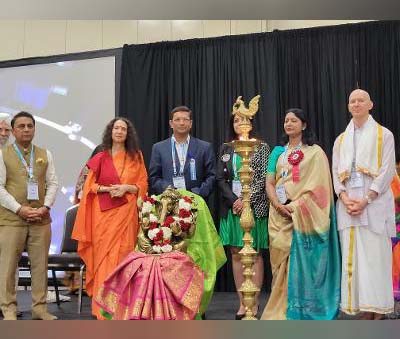 Describing it to be a “historic 40th annual convention celebrating 40 years of AAPI and India’s 75 years of Independence in collaboration with the Indian Consulate in Houston and Indian Embassy with invited dignitaries from the US and India,” Dr. Anupama Gotimukula, the only 4th woman President of AAPI in the four decades-long history of AAP, expressed gratitude to “the entire AAPI leadership and members for their participation in AAPI activities, making AAPI stronger.”
Describing it to be a “historic 40th annual convention celebrating 40 years of AAPI and India’s 75 years of Independence in collaboration with the Indian Consulate in Houston and Indian Embassy with invited dignitaries from the US and India,” Dr. Anupama Gotimukula, the only 4th woman President of AAPI in the four decades-long history of AAP, expressed gratitude to “the entire AAPI leadership and members for their participation in AAPI activities, making AAPI stronger.”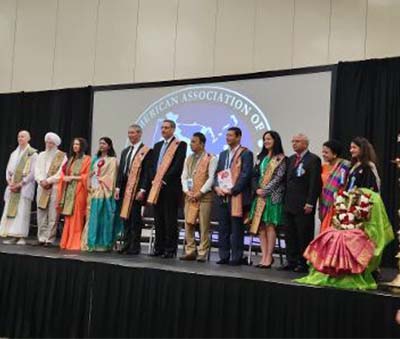 Welcoming AAPI delegates to San Antonio, Ron Nirenberg, Mayor of San Antonio, whom Dr. Jayesh Shah called as the next Governor of Texas, declared June 24th as AAPI Day and International Yoga Day in the City of San Antonio. While praising AAPI and its members for their contributions, Nirenberg said, “We are honored to host the largest gathering of Indian American physicians in our vibrant city, home to some of the best healthcare facilities in the nation.”
Welcoming AAPI delegates to San Antonio, Ron Nirenberg, Mayor of San Antonio, whom Dr. Jayesh Shah called as the next Governor of Texas, declared June 24th as AAPI Day and International Yoga Day in the City of San Antonio. While praising AAPI and its members for their contributions, Nirenberg said, “We are honored to host the largest gathering of Indian American physicians in our vibrant city, home to some of the best healthcare facilities in the nation.”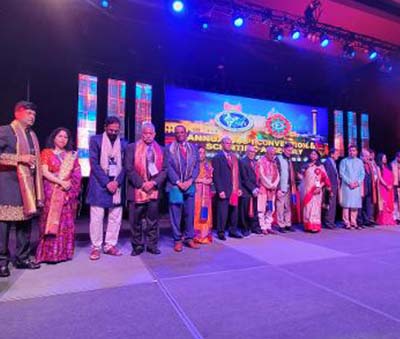 By encouraging manufacturing, innovation, and R&D based on emerging technological landscapes, and transforming India into a hub for medical devices, India may emerge as the “diagnostic capital of the world,” Mahajan said.
By encouraging manufacturing, innovation, and R&D based on emerging technological landscapes, and transforming India into a hub for medical devices, India may emerge as the “diagnostic capital of the world,” Mahajan said. Gavaskar said, he had wanted to be a Doctor as a youth, after he was a witness to how his aunt, a Doctor by profession had touched so many lives by the care she had provided. “Yours is the greatest of all professions in the world. You have put your lives at risk during the Pandemic to save the lives of others. Yours is the noble profession that I have admired always.”
Gavaskar said, he had wanted to be a Doctor as a youth, after he was a witness to how his aunt, a Doctor by profession had touched so many lives by the care she had provided. “Yours is the greatest of all professions in the world. You have put your lives at risk during the Pandemic to save the lives of others. Yours is the noble profession that I have admired always.” In her spiritual discourse, Sadhvi Bhagawati Saraswati, PhD, Spiritual leader, teacher and author, said, “It’s such a joy to be here. Such a deep gratitude. Covid did not create you as heroes, but you have been heroes all along.” Sharing her own personal journey, she said, we all have only one life and how her coming to the banks of the Himalayas, transformed her own lifafter having experienced the unique culture and wisdom of India. While pointing to how we are creating a vicious negative health through fear, stress and anxiety in this country, her message today was to focus on the Synonym for HEALTH: Health, Embrace, Allow, Love, Time for yourself, and Help others.
In her spiritual discourse, Sadhvi Bhagawati Saraswati, PhD, Spiritual leader, teacher and author, said, “It’s such a joy to be here. Such a deep gratitude. Covid did not create you as heroes, but you have been heroes all along.” Sharing her own personal journey, she said, we all have only one life and how her coming to the banks of the Himalayas, transformed her own lifafter having experienced the unique culture and wisdom of India. While pointing to how we are creating a vicious negative health through fear, stress and anxiety in this country, her message today was to focus on the Synonym for HEALTH: Health, Embrace, Allow, Love, Time for yourself, and Help others.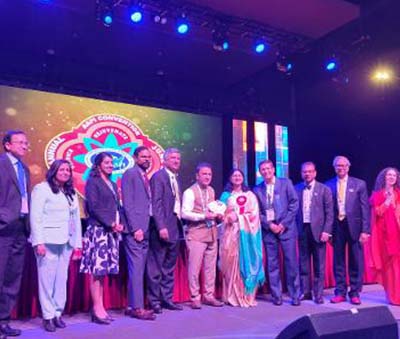 In his live video message, Paramaguru Sharath Jois, Lineage holder of Ashtanga Yoga, told AAPI leaders as to how “each of you have sacrificed your life. I congratulate the organizers for focusing on heal the healers and using Yoga our traditional method to help us in our daily lives.” In his message, he said, “We all experience similar things in life, but respond from our inner self. How we tend to react to people and situations makes the difference. When you abuse a situation it’s agitation, but when you use them effectively it’s liberation.” Referring to the 7th anniversary of India’s Independence he said, “It must help us transcend all that divide us on the basis of caste, creed and status.”
In his live video message, Paramaguru Sharath Jois, Lineage holder of Ashtanga Yoga, told AAPI leaders as to how “each of you have sacrificed your life. I congratulate the organizers for focusing on heal the healers and using Yoga our traditional method to help us in our daily lives.” In his message, he said, “We all experience similar things in life, but respond from our inner self. How we tend to react to people and situations makes the difference. When you abuse a situation it’s agitation, but when you use them effectively it’s liberation.” Referring to the 7th anniversary of India’s Independence he said, “It must help us transcend all that divide us on the basis of caste, creed and status.”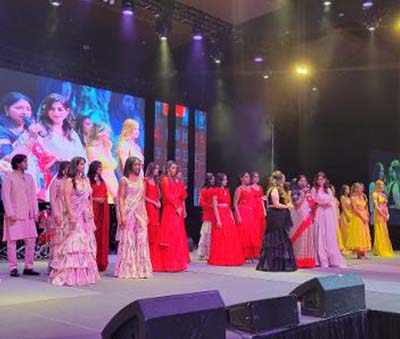 The panelists at the prestigious Women’s Forum included: Dr. Juby A. Jacob-Nara, a Public Health Physician, Vice President and Head of Global Medical Respiratory Allergy & Gastroenterology (Sanofi-Genzyme) who has been a part of over 50 new medicines successfully launched including vaccines in the US and globally; Dr. Kalpalatha Guntupalli, Endowed Professor for Pulmonary Disorders, Baylor College of Medicine; Dr. Sowjanya Mohan, Group Chief Medical Officer, Texas Group/Tenet Health; and, Ms. Rosemary Hickman, Semmes Foundation Education Manager at the Mcnay Art Museum.
The panelists at the prestigious Women’s Forum included: Dr. Juby A. Jacob-Nara, a Public Health Physician, Vice President and Head of Global Medical Respiratory Allergy & Gastroenterology (Sanofi-Genzyme) who has been a part of over 50 new medicines successfully launched including vaccines in the US and globally; Dr. Kalpalatha Guntupalli, Endowed Professor for Pulmonary Disorders, Baylor College of Medicine; Dr. Sowjanya Mohan, Group Chief Medical Officer, Texas Group/Tenet Health; and, Ms. Rosemary Hickman, Semmes Foundation Education Manager at the Mcnay Art Museum.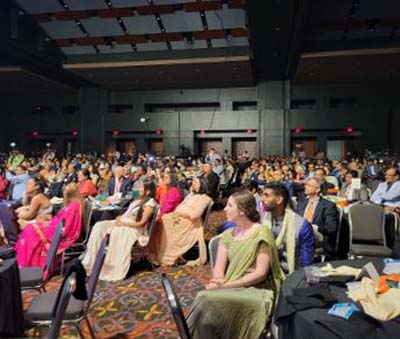 Some of the major themes at the convention include: Yoga and Meditation practices, Welcome kit with books & self-care supplies, A Personal Reflexology Session, Take home wellness routine, Ailment based yoga therapy sessions, Workshop on Spiritual well-being, Book talk with Yoga Gurus, including on the science of Yoga & Lifestyle medicine. Yoga gurus and experts leading the wellness sessions include Paramguru Sharatha Jois, Sadhvi Bhagawati, Saraswati Eddie Stern, Dr. Sat Bir Khalsa, Dr. Dilip Sarkar, Dr. Pankaj Vij, and Dr. Param Dedhia.
Some of the major themes at the convention include: Yoga and Meditation practices, Welcome kit with books & self-care supplies, A Personal Reflexology Session, Take home wellness routine, Ailment based yoga therapy sessions, Workshop on Spiritual well-being, Book talk with Yoga Gurus, including on the science of Yoga & Lifestyle medicine. Yoga gurus and experts leading the wellness sessions include Paramguru Sharatha Jois, Sadhvi Bhagawati, Saraswati Eddie Stern, Dr. Sat Bir Khalsa, Dr. Dilip Sarkar, Dr. Pankaj Vij, and Dr. Param Dedhia.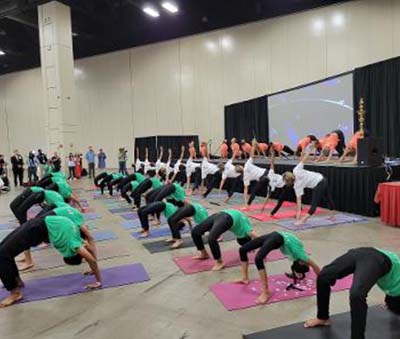 AAPI delegates have the opportunity to attend a multidisciplinary CME conference that allows specialists and primary care physicians to interact in an academic forum. World-renowned speakers discussed gaps between current and best practice of wide-ranging topics at the CME sessions.
AAPI delegates have the opportunity to attend a multidisciplinary CME conference that allows specialists and primary care physicians to interact in an academic forum. World-renowned speakers discussed gaps between current and best practice of wide-ranging topics at the CME sessions.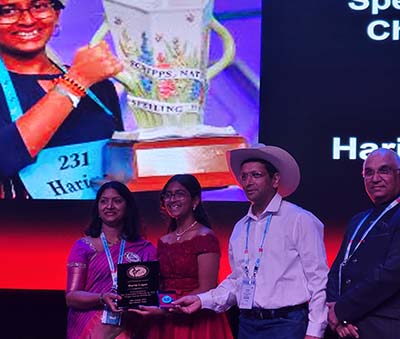 There was a sense of joy and relief on the faces of the over 1,000 physicians who have come together to celebrate their achievements, contributions, and to network and deepen their relationship even as the Covid Pandemic is waning and people are able to mingle freely and interact with one another cautiously.
There was a sense of joy and relief on the faces of the over 1,000 physicians who have come together to celebrate their achievements, contributions, and to network and deepen their relationship even as the Covid Pandemic is waning and people are able to mingle freely and interact with one another cautiously.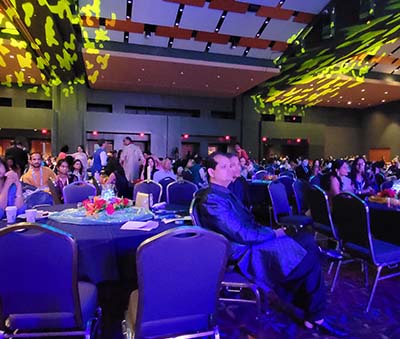 “Our physician members have worked very hard during the covid 19 pandemic. The 2022 convention is a perfect time to heal the healers with a special focus on wellness,” said Dr. Jayesh Shah, Chair of AAPI Convention 2022. Dr. Shah praised the dedication and generosity of each member for giving their best, to make this Convention truly a memorable one for every participant.
“Our physician members have worked very hard during the covid 19 pandemic. The 2022 convention is a perfect time to heal the healers with a special focus on wellness,” said Dr. Jayesh Shah, Chair of AAPI Convention 2022. Dr. Shah praised the dedication and generosity of each member for giving their best, to make this Convention truly a memorable one for every participant. Honoring India and its 75 years of Independence Day celebrations- co-sponsored by the Embassy of India & the Consulate General of India (CGI) – Houston, AAPI delegates had a rare glimpse to the rich cultural heritage of India through a video presentation depicting the unique diversity of India and a variety mesmerizing performance of Indian/Mexican Fusion Dances, ranging from Bharatnatyam, folk dances, and the traditional Indian dances in sync with Mexican pop dances, which were a treat to the hearts and souls of everyone. National Spieling Bee Champion 2022 Harini Logan was recognized during the convention Gala.
Honoring India and its 75 years of Independence Day celebrations- co-sponsored by the Embassy of India & the Consulate General of India (CGI) – Houston, AAPI delegates had a rare glimpse to the rich cultural heritage of India through a video presentation depicting the unique diversity of India and a variety mesmerizing performance of Indian/Mexican Fusion Dances, ranging from Bharatnatyam, folk dances, and the traditional Indian dances in sync with Mexican pop dances, which were a treat to the hearts and souls of everyone. National Spieling Bee Champion 2022 Harini Logan was recognized during the convention Gala. The convention is focused on themes such as how to take care of self and find satisfaction and happiness in the challenging situations they are in, while serving hundreds of patients everyday of their dedicated and noble profession.
The convention is focused on themes such as how to take care of self and find satisfaction and happiness in the challenging situations they are in, while serving hundreds of patients everyday of their dedicated and noble profession.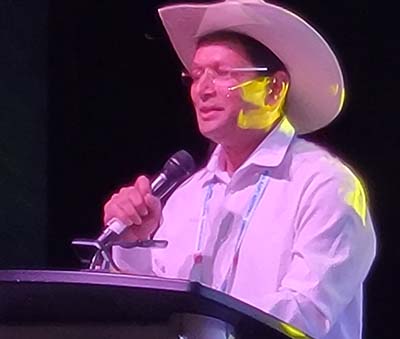 Some of the major events at the convention include: Workshops and hands-on sessions on well-being, 10-12 hours of CMEs, Women’s Forum, CEOs Forum, AAPI Got Talent, Mehfil, Bollywood Nite, Fashion Show, Medical Jeopardy, Poster/Research Contest, Alumni and Young Physicians events and Exhibition and Sale of Jewelry, Clothing, Medical Equipment, Pharma, Finance and many more.
Some of the major events at the convention include: Workshops and hands-on sessions on well-being, 10-12 hours of CMEs, Women’s Forum, CEOs Forum, AAPI Got Talent, Mehfil, Bollywood Nite, Fashion Show, Medical Jeopardy, Poster/Research Contest, Alumni and Young Physicians events and Exhibition and Sale of Jewelry, Clothing, Medical Equipment, Pharma, Finance and many more.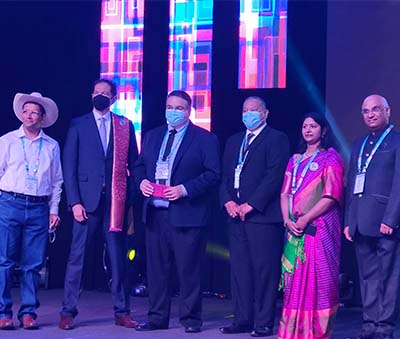 “Welcome to my home city, San Antonio and thank you for coming here to the annual convention offering extensive academic presentations, recognition of achievements and achievers, and professional networking at the alumni and evening social events,” Dr. Gotimukula added. For more details, please visit:
“Welcome to my home city, San Antonio and thank you for coming here to the annual convention offering extensive academic presentations, recognition of achievements and achievers, and professional networking at the alumni and evening social events,” Dr. Gotimukula added. For more details, please visit: 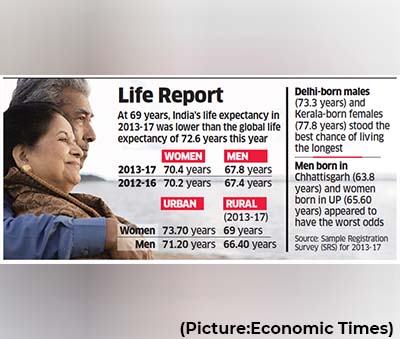 A look at life expectancy at age one and at age five in this period suggests high infant and under-five mortality could be the reason India finds it difficult to raise life expectancy at birth faster.
A look at life expectancy at age one and at age five in this period suggests high infant and under-five mortality could be the reason India finds it difficult to raise life expectancy at birth faster.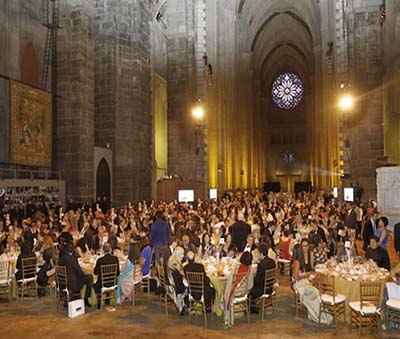 The government schools engaged in the DE program show improved learning outcomes in STEM subjects alongside a marked increase in the utilization of technology for teachers and students. IBM’s partnership with AIF focuses particularly on STEM education for girls to narrow the digital divide and increase the number of girls in STEM careers over time, the press release said.
The government schools engaged in the DE program show improved learning outcomes in STEM subjects alongside a marked increase in the utilization of technology for teachers and students. IBM’s partnership with AIF focuses particularly on STEM education for girls to narrow the digital divide and increase the number of girls in STEM careers over time, the press release said.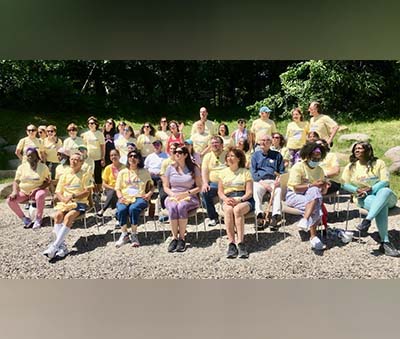 GOPIO-CT donated about $2,300 this year with physical presence of seven of its members.
GOPIO-CT donated about $2,300 this year with physical presence of seven of its members.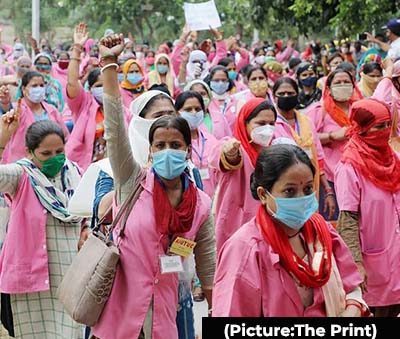 “Let’s hope the award draws attention to their working conditions,”
“Let’s hope the award draws attention to their working conditions,”  The authors also note that although firearm fatality rates started to rise in 2014, the dramatic societal upheaval of the COVID-19 pandemic likely accelerated this increase with the escalation of mental health stressors and existential despair experienced by youth. The seismic shift in youths’ lives during the pandemic occurred in the context of a decades’ long void of prevention efforts to decrease firearm injuries and deaths.
The authors also note that although firearm fatality rates started to rise in 2014, the dramatic societal upheaval of the COVID-19 pandemic likely accelerated this increase with the escalation of mental health stressors and existential despair experienced by youth. The seismic shift in youths’ lives during the pandemic occurred in the context of a decades’ long void of prevention efforts to decrease firearm injuries and deaths.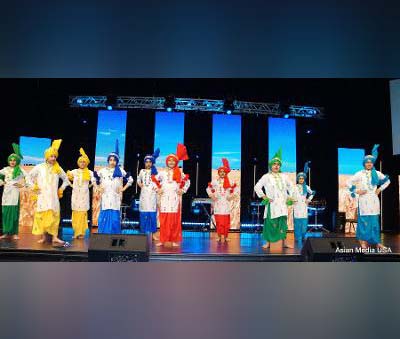 Dr. Param P. Singh a cardiovascular physician from Moline Illinois, who won “The Young Investigator Award” from AACIO in 2010, was the chief guest.
Dr. Param P. Singh a cardiovascular physician from Moline Illinois, who won “The Young Investigator Award” from AACIO in 2010, was the chief guest.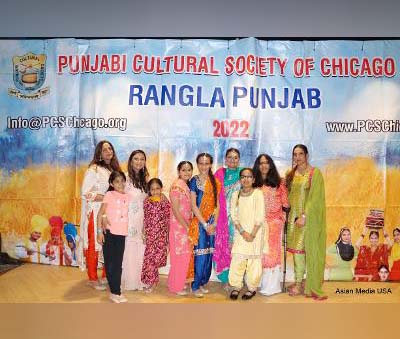 This part was emceed by the local youth who were encouraged to speak in Punjabi. The first half was divided into four segments which were emceed by Karan Gill & Gurneer Sidhu; Gurkiran Kaur, Mankirth Singh & Harnoor Singh; Gia Dhaliwal & Guru Dhaliwal; Simran Bhalla & Manpreet Bhalla.
This part was emceed by the local youth who were encouraged to speak in Punjabi. The first half was divided into four segments which were emceed by Karan Gill & Gurneer Sidhu; Gurkiran Kaur, Mankirth Singh & Harnoor Singh; Gia Dhaliwal & Guru Dhaliwal; Simran Bhalla & Manpreet Bhalla.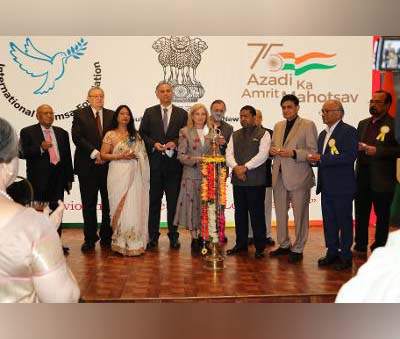 Dr. Jain dwelt on Lord Mahavir who was born in 599 B.C. during the program entitled, “Non-Violence “A Message of Lord Mahavir” on this his 2,620th birth anniversary. She noted the 5 basic principles of Jainism – Non-violence, truthfulness, non-stealing, self-control, and non-possession. She stressed on teaching children the 5 Jain principles to make the world a better place. She also said the Lord Mahavir is the one who told the wotld that “Non-Violence is the Supreme Religon”
Dr. Jain dwelt on Lord Mahavir who was born in 599 B.C. during the program entitled, “Non-Violence “A Message of Lord Mahavir” on this his 2,620th birth anniversary. She noted the 5 basic principles of Jainism – Non-violence, truthfulness, non-stealing, self-control, and non-possession. She stressed on teaching children the 5 Jain principles to make the world a better place. She also said the Lord Mahavir is the one who told the wotld that “Non-Violence is the Supreme Religon”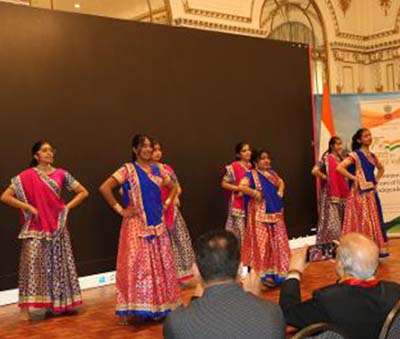 Sister Sabita from Brahma Kumaris at U.N. led the gathering in a moment of contemplation and meditation through breathing exercises. Ambassador Nitzan in his speech, also said on how leaders in several countries had followed the teachings of nonviolence and Ahimsa, which if adhered to by everyone, would not lead to tragedies like the killings in Buffalo or the war in Ukraine. Consul General Jaiswal said he has a special connection to Lord Mahavir because he was born in the same town, Trishala, in Bihar. The Consulate celebrates Mahavir Jayanti every year, he noted, but this year it was even more important as it was part of the Azadi ka Amrit Mahotsav, India’s 75th independence year. “Walk on the path of Lord Mahavir so that we can build a better world to live.
Sister Sabita from Brahma Kumaris at U.N. led the gathering in a moment of contemplation and meditation through breathing exercises. Ambassador Nitzan in his speech, also said on how leaders in several countries had followed the teachings of nonviolence and Ahimsa, which if adhered to by everyone, would not lead to tragedies like the killings in Buffalo or the war in Ukraine. Consul General Jaiswal said he has a special connection to Lord Mahavir because he was born in the same town, Trishala, in Bihar. The Consulate celebrates Mahavir Jayanti every year, he noted, but this year it was even more important as it was part of the Azadi ka Amrit Mahotsav, India’s 75th independence year. “Walk on the path of Lord Mahavir so that we can build a better world to live.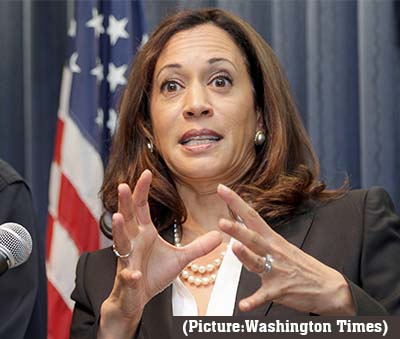 In her pre-recorded speech played on May 18, Harris recalled her mother’s work in cancer research and how she and her sister were taught to “Dream with Ambition,” by their mother.
In her pre-recorded speech played on May 18, Harris recalled her mother’s work in cancer research and how she and her sister were taught to “Dream with Ambition,” by their mother.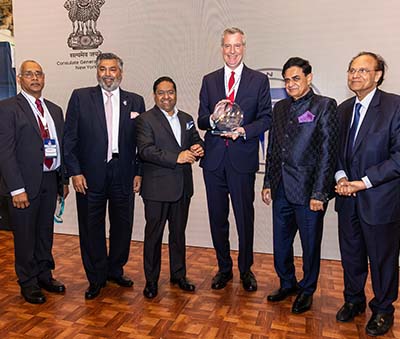 Four distinguished and accomplished community leaders/professionals were honored with the Lifetime Achievement Awards for their accomplishments and contributions to the larger society.
Four distinguished and accomplished community leaders/professionals were honored with the Lifetime Achievement Awards for their accomplishments and contributions to the larger society. The other honoree whom IAPC recognized today was Sudhir M. Parikh, M.D., a physician by profession and currently the Chairman and Publisher of Parikh Worldwide Media Inc., the largest Indian-American publishing group in the United States, and Chairman of ITV Gold, a 24×7 TV news channel, and is one of the most honored Indian Americans with Padma Shri and Pravasi Bharatiya Samman, and the Ellis Island Medal of Honor.
The other honoree whom IAPC recognized today was Sudhir M. Parikh, M.D., a physician by profession and currently the Chairman and Publisher of Parikh Worldwide Media Inc., the largest Indian-American publishing group in the United States, and Chairman of ITV Gold, a 24×7 TV news channel, and is one of the most honored Indian Americans with Padma Shri and Pravasi Bharatiya Samman, and the Ellis Island Medal of Honor.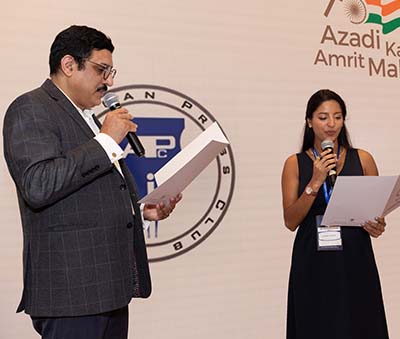 We look forward to their continued support to bring developments from India to the readers in the US and carry all the excitement from the United States to the people of India. I invite Indo American Press Club to join hands with us in celebrating India@75, our Azadi Ka Amrit Mahotsav. I wish the Club steady growth, progress and success,” he said.
We look forward to their continued support to bring developments from India to the readers in the US and carry all the excitement from the United States to the people of India. I invite Indo American Press Club to join hands with us in celebrating India@75, our Azadi Ka Amrit Mahotsav. I wish the Club steady growth, progress and success,” he said. IAPC envisages its vision through collective efforts and advocacy activities through its nearly one thousand members across the US and Canada, by being a link between the media fraternity and the world at large. We will work together with dedication to enhance the working conditions of our journalists, exchanging ideas and offering educational and training opportunities to our members, aspiring young journalists and media professionals around the globe.”
IAPC envisages its vision through collective efforts and advocacy activities through its nearly one thousand members across the US and Canada, by being a link between the media fraternity and the world at large. We will work together with dedication to enhance the working conditions of our journalists, exchanging ideas and offering educational and training opportunities to our members, aspiring young journalists and media professionals around the globe.”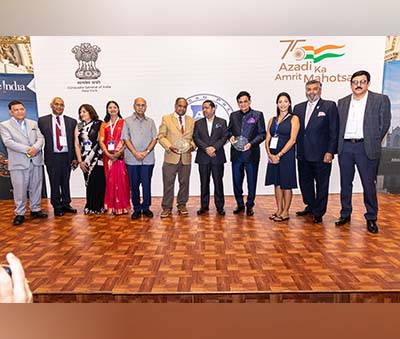 Providing the background to the formation of IAPC, Akay Ghosh, Founding President of IAPC said, “We as individuals and corporations that represent the media world, consisting of print, visual, electronic and online, realize that we have a greater role to play. We have been working in this field for decades and often stand alone in a large media world. As individual members of the media, our voice is often drowned in the very large world of multi-media. We lack a collective voice to raise our voice, to pool our talents together and work as a cohesive group to reflect and respond to the challenges of the modern world. IAPC was (IAPC), formed to fill this vacuum, and is committed to strive to be a common platform to raise the voice and explore the possibilities of helping shape the world to be a world that is fair, just and equitable for today and future generations.”
Providing the background to the formation of IAPC, Akay Ghosh, Founding President of IAPC said, “We as individuals and corporations that represent the media world, consisting of print, visual, electronic and online, realize that we have a greater role to play. We have been working in this field for decades and often stand alone in a large media world. As individual members of the media, our voice is often drowned in the very large world of multi-media. We lack a collective voice to raise our voice, to pool our talents together and work as a cohesive group to reflect and respond to the challenges of the modern world. IAPC was (IAPC), formed to fill this vacuum, and is committed to strive to be a common platform to raise the voice and explore the possibilities of helping shape the world to be a world that is fair, just and equitable for today and future generations.”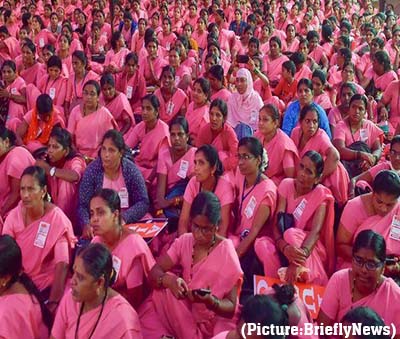 Dr Tedros decides on the awardees for the World Health Organisation Director-General’s Global Health Leaders Awards. The ceremony for the awards, which were established in 2019, was part of the live-streamed high-level opening session of the 75th World Health Assembly.
Dr Tedros decides on the awardees for the World Health Organisation Director-General’s Global Health Leaders Awards. The ceremony for the awards, which were established in 2019, was part of the live-streamed high-level opening session of the 75th World Health Assembly.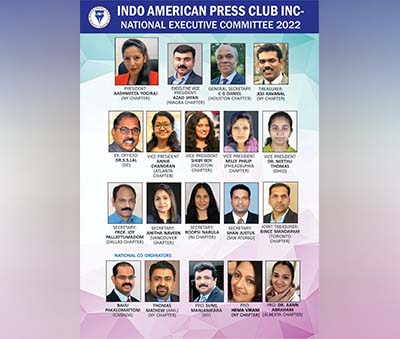 The event, which will be attended by several dignitaries, including former New York City Mayor Bill de Blasio; Dr. Prabhakar Kore, Member of Parliament, India; Kevin Thomas, New York State Senator; Harry Arora, State Assemblyman, Connecticut; Malkit Singh, Music Legend, and several other elected officials, will surely go down in IAPC history.
The event, which will be attended by several dignitaries, including former New York City Mayor Bill de Blasio; Dr. Prabhakar Kore, Member of Parliament, India; Kevin Thomas, New York State Senator; Harry Arora, State Assemblyman, Connecticut; Malkit Singh, Music Legend, and several other elected officials, will surely go down in IAPC history.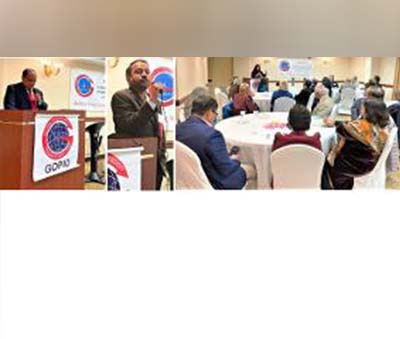 Dr. Abraham also spoke on the Welcome Dinner for new students from India at the UConn Business School at Stamford and Hartford campuses organized by GOPIO-CT and hoping to do the same in the Hamden/New Haven area.
Dr. Abraham also spoke on the Welcome Dinner for new students from India at the UConn Business School at Stamford and Hartford campuses organized by GOPIO-CT and hoping to do the same in the Hamden/New Haven area.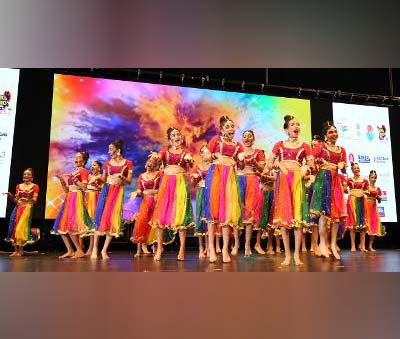 Hon CG Shree Randhir Jaswal welcomed the guests and said that the Indian Diaspora from both the states of Gujarat and Maharashtra, not only in America but in other countries as well, continues to contribute towards the economic and social progress of the countries they live in.
Hon CG Shree Randhir Jaswal welcomed the guests and said that the Indian Diaspora from both the states of Gujarat and Maharashtra, not only in America but in other countries as well, continues to contribute towards the economic and social progress of the countries they live in.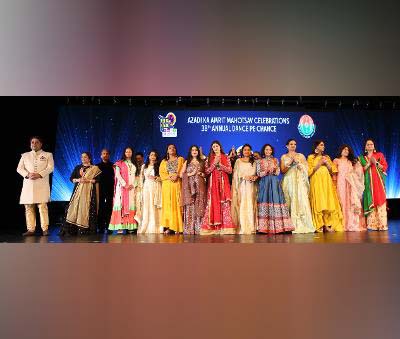 One minute silence was observed in the memory of founding member, Past President and Vice Chairman Emeritus Late Mr. Yashpal Soi. Mr. Vaidya remembered him for his selfless service and dedication to the cause of FIA and lamented the loss FIA has suffered in his passing away.
One minute silence was observed in the memory of founding member, Past President and Vice Chairman Emeritus Late Mr. Yashpal Soi. Mr. Vaidya remembered him for his selfless service and dedication to the cause of FIA and lamented the loss FIA has suffered in his passing away.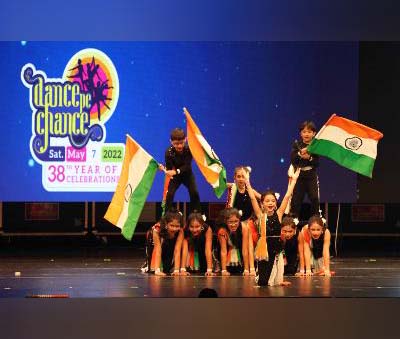 Event Chair, Past President, and member of Board of Trustees of FIA, Sh. Srujal Parikh said it’s a great honor to celebrate the event and took pride in the fact that Gujarat is the Land of Lord Krishna & Mahatma Gandhi. He recognized and felicitated the sponsors, supporters, partner associations, and members in their effort to make the event successful
Event Chair, Past President, and member of Board of Trustees of FIA, Sh. Srujal Parikh said it’s a great honor to celebrate the event and took pride in the fact that Gujarat is the Land of Lord Krishna & Mahatma Gandhi. He recognized and felicitated the sponsors, supporters, partner associations, and members in their effort to make the event successful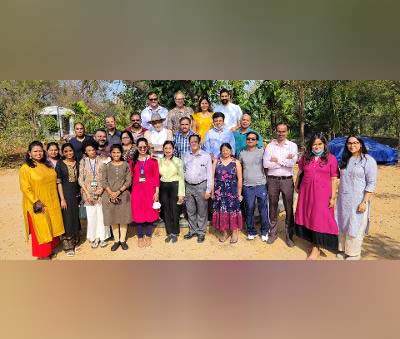 AAPI, the largest ethnic medical organization in the country, representing the interests of over 100,000 physicians of Indian origin, has been focusing on ways to help AAPI members, who have been in the forefront helping millions of patients around the nation, to take care of self and find satisfaction and happiness in the challenging situations they are in, while serving hundreds of patients everyday of their dedicated and noble profession, Dr. Anupama Gotimukula said.
AAPI, the largest ethnic medical organization in the country, representing the interests of over 100,000 physicians of Indian origin, has been focusing on ways to help AAPI members, who have been in the forefront helping millions of patients around the nation, to take care of self and find satisfaction and happiness in the challenging situations they are in, while serving hundreds of patients everyday of their dedicated and noble profession, Dr. Anupama Gotimukula said.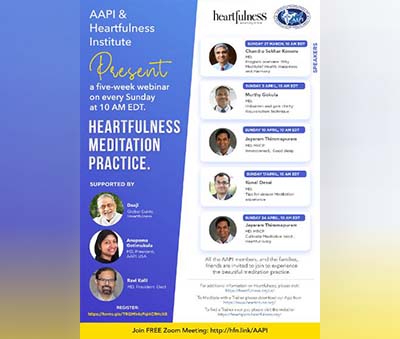 “Our practices include heart-based meditation,” said Dr. Chandra Koneru, an Internal Medicine Professional, AAPI member, and Heartfulness Trainer. “Our values align with the American Association of Physicians of Indian Origin (AAPI) mission to facilitate and enable Indian physicians to improve patient care and engage in research that brings distinctive contributions from India.”
“Our practices include heart-based meditation,” said Dr. Chandra Koneru, an Internal Medicine Professional, AAPI member, and Heartfulness Trainer. “Our values align with the American Association of Physicians of Indian Origin (AAPI) mission to facilitate and enable Indian physicians to improve patient care and engage in research that brings distinctive contributions from India.” Dr. Tajamul Hussain, said all religions teach love and empathy and we have to build bridges and spread love. He opined that practicing these values is the need of the hour for giving a big boost to mutual co- existence, especially in the present times, which are characterized by increasing distances among people professing different faiths. “My hometown is Hyderabad in India, which is known for “Ganga Jamuni Tahzeeb’, that is, a fusion of elements of different religions”, he added.
Dr. Tajamul Hussain, said all religions teach love and empathy and we have to build bridges and spread love. He opined that practicing these values is the need of the hour for giving a big boost to mutual co- existence, especially in the present times, which are characterized by increasing distances among people professing different faiths. “My hometown is Hyderabad in India, which is known for “Ganga Jamuni Tahzeeb’, that is, a fusion of elements of different religions”, he added.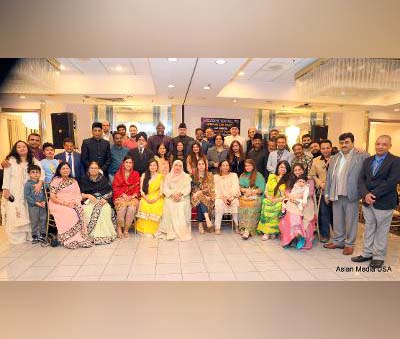 The Chicago Eid Committee presented awards to the community leaders for their excellent service to the community of Chicago and Dr. Suresh Reddy, Dr Rajiv Kandala, Rezwanul Haque, Saima Azfar, Shalini Gupta and Rajendra Singh Mago were awarded. The book release of A.Q. Siddiqui was also done by the Chicago Eid Committee and Mr. Siddiqui signed the copies for the community.
The Chicago Eid Committee presented awards to the community leaders for their excellent service to the community of Chicago and Dr. Suresh Reddy, Dr Rajiv Kandala, Rezwanul Haque, Saima Azfar, Shalini Gupta and Rajendra Singh Mago were awarded. The book release of A.Q. Siddiqui was also done by the Chicago Eid Committee and Mr. Siddiqui signed the copies for the community. He said keeping in mind the spirit of Ek Bharat Shresth Bhara , Midwest Punjabi Association has decided to pay tribute One author from Punjabi ,one from regional language and one from regional language and one from our national language Hindi. We will continue and take forward the spirit of Azadi ka Amrit Mahotsav in all years to come.We all know Gurmeet Singh Dhalwan is a well-known name in the media industry and the Founder President of Adbhhut Media Newspaper and Channel. Dhalwan is an entrepreneur with more than two decades of experience in wholesale & retail business. He is the Founder President of Midwest Punjabi Association, (MPA) a Non-Profit Organization. He is also a member of cultural inclusion and diversity committee/commission Village of Hanover Park, IL. He is a community leader, social worker, and a Philanthropist.
He said keeping in mind the spirit of Ek Bharat Shresth Bhara , Midwest Punjabi Association has decided to pay tribute One author from Punjabi ,one from regional language and one from regional language and one from our national language Hindi. We will continue and take forward the spirit of Azadi ka Amrit Mahotsav in all years to come.We all know Gurmeet Singh Dhalwan is a well-known name in the media industry and the Founder President of Adbhhut Media Newspaper and Channel. Dhalwan is an entrepreneur with more than two decades of experience in wholesale & retail business. He is the Founder President of Midwest Punjabi Association, (MPA) a Non-Profit Organization. He is also a member of cultural inclusion and diversity committee/commission Village of Hanover Park, IL. He is a community leader, social worker, and a Philanthropist.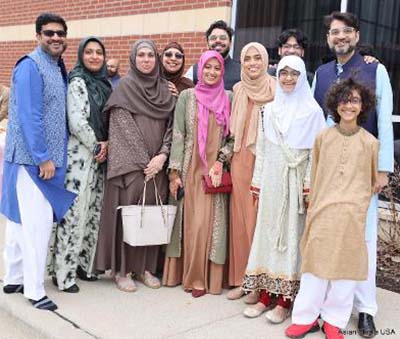 Women in vibrant colored dresses, men in ethnic outfits and children, smiling and laughing, filled the parking lots and poured into all the three locations. Volunteers of the Eid Committee of the ICN open-heartedly welcomed the incoming persons so as to ensure that every one of them was able to partake in the Eid prayers, without any inconvenience. Despite the large numbers, the volunteers of the ICN and board members were able to direct the crowds effortlessly and efficiently.
Women in vibrant colored dresses, men in ethnic outfits and children, smiling and laughing, filled the parking lots and poured into all the three locations. Volunteers of the Eid Committee of the ICN open-heartedly welcomed the incoming persons so as to ensure that every one of them was able to partake in the Eid prayers, without any inconvenience. Despite the large numbers, the volunteers of the ICN and board members were able to direct the crowds effortlessly and efficiently.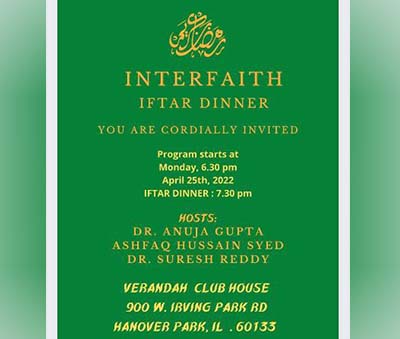 Recognizing the imperative need for dialogue and appreciation among different faiths and religions to enhance mutual understanding, harmony and cooperation among people, an Interfaith Iftar was hosted by Dr. Suresh Reddy, Dr. Anuja Gupta, and Shri Ashfaq Hussain Syed, under the auspices of Verandah Community Outreach on April 25th in Hanover Park, near Chicago, in Illinois. Dr. Suresh Reddy, born and grew up in from Hyderabad, India, a city of many religions, shared his own experiences of Iftar celebrations while growing up in Hyderabad.
Recognizing the imperative need for dialogue and appreciation among different faiths and religions to enhance mutual understanding, harmony and cooperation among people, an Interfaith Iftar was hosted by Dr. Suresh Reddy, Dr. Anuja Gupta, and Shri Ashfaq Hussain Syed, under the auspices of Verandah Community Outreach on April 25th in Hanover Park, near Chicago, in Illinois. Dr. Suresh Reddy, born and grew up in from Hyderabad, India, a city of many religions, shared his own experiences of Iftar celebrations while growing up in Hyderabad. Iftar is the fast-breaking meal observed each evening at sundown during the holy month of Ramadan. The Interfaith Iftar Dinner is an opportunity for the community to join our Muslim friends for an evening meal as they break their Ramadan fast, added Ashfaq Syed. Ramadan is a time of revelation and a time of disruption, he said, in which Muslims draw near to God by breaking away from the distractions of the world.
Iftar is the fast-breaking meal observed each evening at sundown during the holy month of Ramadan. The Interfaith Iftar Dinner is an opportunity for the community to join our Muslim friends for an evening meal as they break their Ramadan fast, added Ashfaq Syed. Ramadan is a time of revelation and a time of disruption, he said, in which Muslims draw near to God by breaking away from the distractions of the world. The Sikh Parade returned to the Big Apple after being on hiatus for the past two-years due to COVID-19. The Parade had added poignancy and significance in light of recent violent incidents in which Sikhs have been attacked in their own residential areas and near Gurudwaras over the last few weeks.
The Sikh Parade returned to the Big Apple after being on hiatus for the past two-years due to COVID-19. The Parade had added poignancy and significance in light of recent violent incidents in which Sikhs have been attacked in their own residential areas and near Gurudwaras over the last few weeks. Music and vibrant decorations adorned floats all throughout the parade. Many Sikh members wearing traditional colored garments and turbans. “It’s a symbol so mostly you will see people today especially wearing blue or yellow turbans otherwise you can wear any color — there is no issue with that,” said Hirdepal Singh member of the Sikh Cultural Society in Queens.
Music and vibrant decorations adorned floats all throughout the parade. Many Sikh members wearing traditional colored garments and turbans. “It’s a symbol so mostly you will see people today especially wearing blue or yellow turbans otherwise you can wear any color — there is no issue with that,” said Hirdepal Singh member of the Sikh Cultural Society in Queens.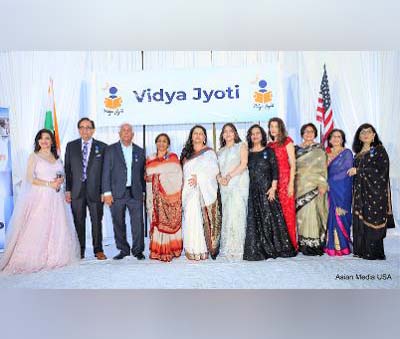 Dr. Santosh Kumar, CEO of Metropolitan Asian Family, in her Keynote address spoke about her own journey and credited education for helping her reach her present position. Mrs. Malti Loomba, retired Director of Schools in India, accompanied by her son Mr. Anil Loomba, performed the ribbon cutting ceremony and offered her blessings to this noble effort. She spoke about her own experiences as teacher, principal and, finally, director and noted the need for support for the many families with limited means. She also extended her willingness to help guide Vidya Jyoti’s work.
Dr. Santosh Kumar, CEO of Metropolitan Asian Family, in her Keynote address spoke about her own journey and credited education for helping her reach her present position. Mrs. Malti Loomba, retired Director of Schools in India, accompanied by her son Mr. Anil Loomba, performed the ribbon cutting ceremony and offered her blessings to this noble effort. She spoke about her own experiences as teacher, principal and, finally, director and noted the need for support for the many families with limited means. She also extended her willingness to help guide Vidya Jyoti’s work.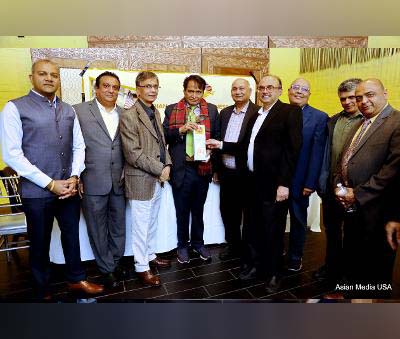 Cultural programs mesmerized the audience with the varieties and the digital projection made the programs livelier. More than 300 kids and Adults participated in the event. Few highlights of the programs were Ramayana, Hanuman Chalisa, Lazy dance by adults, Ugadi theme dances and Senior’s dance etc. Audience enjoyed each and every program with applauds. Cultural committee with the help of others Bod’s Archana Podduturi and Sirisha Madduri ran the program very smoothly. Swaralaya team of singers Ravi Thokala, Mani Thellapragada, Sowjanya and Archana entertained the crowd with their melodious voice and got new energy into the auditorium.
Cultural programs mesmerized the audience with the varieties and the digital projection made the programs livelier. More than 300 kids and Adults participated in the event. Few highlights of the programs were Ramayana, Hanuman Chalisa, Lazy dance by adults, Ugadi theme dances and Senior’s dance etc. Audience enjoyed each and every program with applauds. Cultural committee with the help of others Bod’s Archana Podduturi and Sirisha Madduri ran the program very smoothly. Swaralaya team of singers Ravi Thokala, Mani Thellapragada, Sowjanya and Archana entertained the crowd with their melodious voice and got new energy into the auditorium.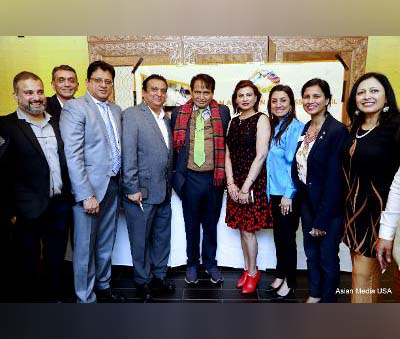 Dr. Suresh Reddy, Trustee Oakbrook Village introduced Suresh Prabhu as a visionary who presided over as central minister with remarkable honor and lauded him for his distinguished credentials that propelled him to the league of top three Indian leaders in Asia.
Dr. Suresh Reddy, Trustee Oakbrook Village introduced Suresh Prabhu as a visionary who presided over as central minister with remarkable honor and lauded him for his distinguished credentials that propelled him to the league of top three Indian leaders in Asia.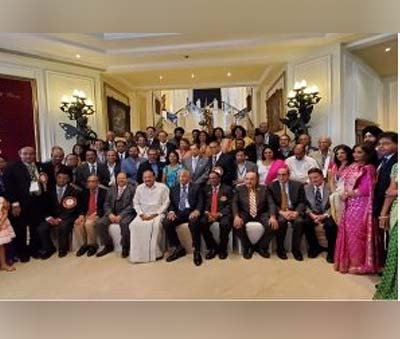 There is no instant solution for India’s myriad problems. But by collaborating with the governments both nationally and at state levels, and working with the government and NGOs, physicians of Indian origin can make a huge difference.
There is no instant solution for India’s myriad problems. But by collaborating with the governments both nationally and at state levels, and working with the government and NGOs, physicians of Indian origin can make a huge difference. The Indian Consul General Randhir Kumar Jaiswal was the chief guest along with Consul for Community Affairs A.K. Vijayakrishnan. Many prominent Indian American community leaders, elected council members from Edison and nearby cities, media and a large number of community leaders and Indian American residents from Edison and nearby towns attended the event to show their support to this initiative by GOPIO-Edison.
The Indian Consul General Randhir Kumar Jaiswal was the chief guest along with Consul for Community Affairs A.K. Vijayakrishnan. Many prominent Indian American community leaders, elected council members from Edison and nearby cities, media and a large number of community leaders and Indian American residents from Edison and nearby towns attended the event to show their support to this initiative by GOPIO-Edison.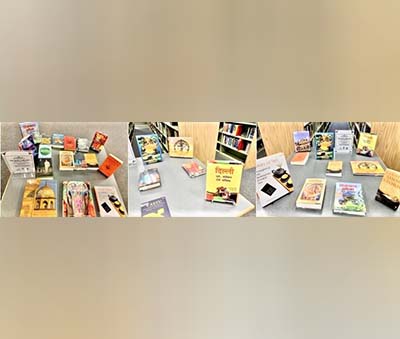 Speaking on the occasion, Consul General Randhir Jaiswal spoke on the vibrant library system in America that helps spread knowledge and make it a developed country. He said that American Indian partnership is crucial for world peace and security and lauded the efforts of Diaspora in getting this initiative to Edison. He said that the libraries in USA are the best in the world and making the Indian Books available thru this system will help Diaspora with the availability of rare Indian books.
Speaking on the occasion, Consul General Randhir Jaiswal spoke on the vibrant library system in America that helps spread knowledge and make it a developed country. He said that American Indian partnership is crucial for world peace and security and lauded the efforts of Diaspora in getting this initiative to Edison. He said that the libraries in USA are the best in the world and making the Indian Books available thru this system will help Diaspora with the availability of rare Indian books.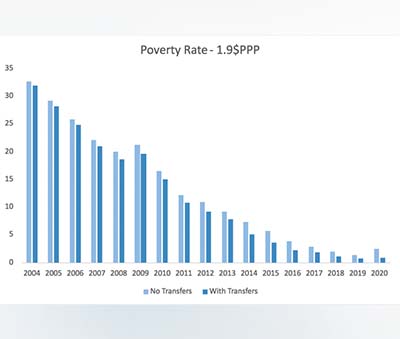 Source: NSS 2011-12 MMRP data; Private Final Consumption Expenditure (PFCE) growth rates for estimates of monthly per capita consumption; authors’ calculations.
Source: NSS 2011-12 MMRP data; Private Final Consumption Expenditure (PFCE) growth rates for estimates of monthly per capita consumption; authors’ calculations.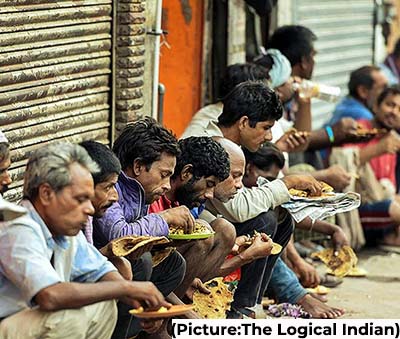 Our paper presents a consistent time series of poverty and (real) inequality in India for each of the years 2004-2020. Our estimate of real inequality (Figure 3) shows that consumption inequality has also declined, and in 2020 is very close to the lowest historical level of 0.28. Poverty and inequality trends can be emotive, controversial, and confusing. Consumption inequality is lower than income inequality, which itself is lower than wealth inequality. And each can show different trends. The levels and trends are different, and intermingled use should carry a warning about this when discussing “inequality.”
Our paper presents a consistent time series of poverty and (real) inequality in India for each of the years 2004-2020. Our estimate of real inequality (Figure 3) shows that consumption inequality has also declined, and in 2020 is very close to the lowest historical level of 0.28. Poverty and inequality trends can be emotive, controversial, and confusing. Consumption inequality is lower than income inequality, which itself is lower than wealth inequality. And each can show different trends. The levels and trends are different, and intermingled use should carry a warning about this when discussing “inequality.”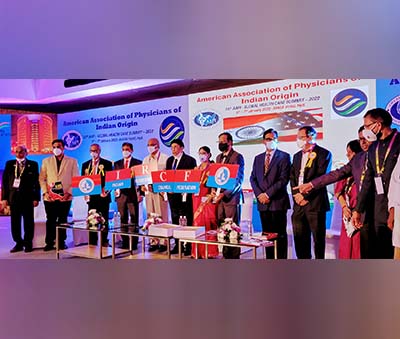 Since its inception four decades ago, the American Association of Physicians of Indian Origin (AAPI) has grown and is strong today and is the largest ethnic medical organization in the United States, representing the interests of over 100,000 physicians of Indian Origin in the US and is the powerful voice here in the US and back home in India.
Since its inception four decades ago, the American Association of Physicians of Indian Origin (AAPI) has grown and is strong today and is the largest ethnic medical organization in the United States, representing the interests of over 100,000 physicians of Indian Origin in the US and is the powerful voice here in the US and back home in India. Realizing this great mission, AAPI is for the first time organizing an In-Person Plenary Session on India-USA Healthcare Partnership With the Health Minister Of India, Mansukh Mandaviya (invited but awaiting confirmation from his office) during the 40th Annual Convention of AAPI on Saturday, June 25, 2022, at the Henry B. Gonzalez Convention Center, San Antonio, TX, said Dr. Jayesh Shah, Chair, AAPI Convention & Past President, AAPI.
Realizing this great mission, AAPI is for the first time organizing an In-Person Plenary Session on India-USA Healthcare Partnership With the Health Minister Of India, Mansukh Mandaviya (invited but awaiting confirmation from his office) during the 40th Annual Convention of AAPI on Saturday, June 25, 2022, at the Henry B. Gonzalez Convention Center, San Antonio, TX, said Dr. Jayesh Shah, Chair, AAPI Convention & Past President, AAPI. In New York, such a rapid and large-scale loss of life meant that the city’s engine sputtered to an even more devastating halt; in other places, like Mexico and Ecuador, Bangladesh and Nepal, it meant that many families could no longer rely on support from relatives in Queens who were suddenly out of work, or worse.
In New York, such a rapid and large-scale loss of life meant that the city’s engine sputtered to an even more devastating halt; in other places, like Mexico and Ecuador, Bangladesh and Nepal, it meant that many families could no longer rely on support from relatives in Queens who were suddenly out of work, or worse.  Since the 1990s, and especially after major climbing disasters on Everest, Sherpa have left Nepal in large numbers. Many have come to the area around Roosevelt Avenue, where they often work as taxi drivers, or restaurant cooks and supermarket employees. The United Sherpa Association is a central meeting point of worship and community—where people chant and pray, gather for meals of dhal and root-vegetable stews, and share opportunities for work or study.
Since the 1990s, and especially after major climbing disasters on Everest, Sherpa have left Nepal in large numbers. Many have come to the area around Roosevelt Avenue, where they often work as taxi drivers, or restaurant cooks and supermarket employees. The United Sherpa Association is a central meeting point of worship and community—where people chant and pray, gather for meals of dhal and root-vegetable stews, and share opportunities for work or study.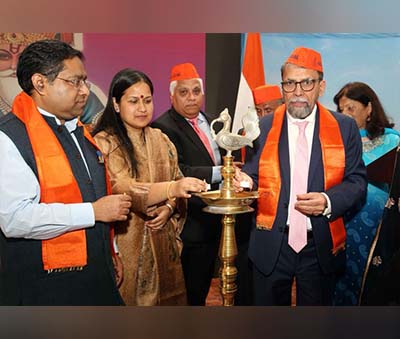 New Year at Indian Consulate in New York.
New Year at Indian Consulate in New York.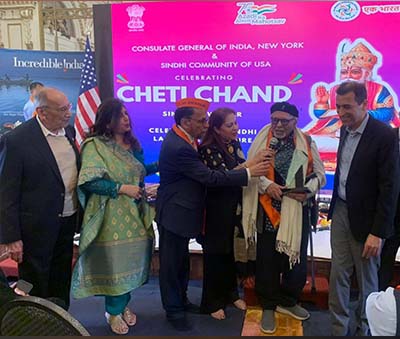 Sewhani said that Sindhi language is in decline. Today youngsters don’t speak Sindhi language. In a passionate appeal to Sindhis he urged them to speak with their children in Sindhi . Sindhi is our Ancestral language. It’s very important that if you want Sindhi community to be alive , Sindhi language has to be spoken at home with children.
Sewhani said that Sindhi language is in decline. Today youngsters don’t speak Sindhi language. In a passionate appeal to Sindhis he urged them to speak with their children in Sindhi . Sindhi is our Ancestral language. It’s very important that if you want Sindhi community to be alive , Sindhi language has to be spoken at home with children.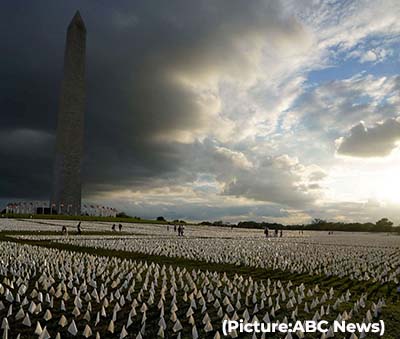 Adolescent overdose death counts were fairly constant for most of the last decade, at around 500 a year, according to the paper published by the Journal of the American Medical Association. They almost doubled in 2020, to 954, and the researchers estimated that the total hit nearly 1,150 last year.
Adolescent overdose death counts were fairly constant for most of the last decade, at around 500 a year, according to the paper published by the Journal of the American Medical Association. They almost doubled in 2020, to 954, and the researchers estimated that the total hit nearly 1,150 last year. The 2nd phase of the free vaccination camp was inaugurated with the lighting of the traditional lamp by IMA’s Telangana President Sampath Rao, IMA North President Raghunandan, Secretary Surendranath, Dr. Meeta Singh, and Dr. Naunihal Singh. AAPI Advisor Dr. Dwarakanatha Reddy inaugurated the vaccination camp. ““If vaccination programs are effectively implemented, approximately 90 percent of invasive cervical cancer cases worldwide could be prevented, in addition to the majority of precancerous lesions,” Dr. Dwarakanatha Reddy said.
The 2nd phase of the free vaccination camp was inaugurated with the lighting of the traditional lamp by IMA’s Telangana President Sampath Rao, IMA North President Raghunandan, Secretary Surendranath, Dr. Meeta Singh, and Dr. Naunihal Singh. AAPI Advisor Dr. Dwarakanatha Reddy inaugurated the vaccination camp. ““If vaccination programs are effectively implemented, approximately 90 percent of invasive cervical cancer cases worldwide could be prevented, in addition to the majority of precancerous lesions,” Dr. Dwarakanatha Reddy said. According to The American Cancer Society, Cervical Cancer was once one of the most common causes of cancer death for American women. The cervical cancer death rate dropped significantly with the increased use of the Pap test for screening. Cervical cancer is among a number of cancers that can be caused by infections with pathogens – bacteria, viruses, and parasites.
According to The American Cancer Society, Cervical Cancer was once one of the most common causes of cancer death for American women. The cervical cancer death rate dropped significantly with the increased use of the Pap test for screening. Cervical cancer is among a number of cancers that can be caused by infections with pathogens – bacteria, viruses, and parasites. The Association of Indians in America is the oldest Indian organization in the United States. It was established in 1967 with the anticipation that as a change of the immigration law, there will be greater immigration of Indian people to the United States. One of the objectives was to help and facilitate the participation and the assimilation of the incoming Indian immigrants to the United States society in the country of their choice.
The Association of Indians in America is the oldest Indian organization in the United States. It was established in 1967 with the anticipation that as a change of the immigration law, there will be greater immigration of Indian people to the United States. One of the objectives was to help and facilitate the participation and the assimilation of the incoming Indian immigrants to the United States society in the country of their choice. 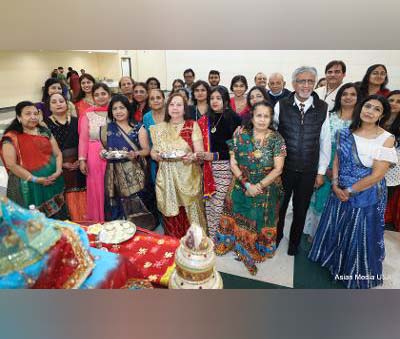 Chaitra Navratri is a nine days festivity which starts on the first day of Hindu Luni-Solar calendar and falls in the month of March or April. Chaitra is the first month of Hindu lunar calendar and because of it this Navratri is known as Chaitra Navratri. Chaitra Navratri is also known as Vasanta Navratri.
Chaitra Navratri is a nine days festivity which starts on the first day of Hindu Luni-Solar calendar and falls in the month of March or April. Chaitra is the first month of Hindu lunar calendar and because of it this Navratri is known as Chaitra Navratri. Chaitra Navratri is also known as Vasanta Navratri.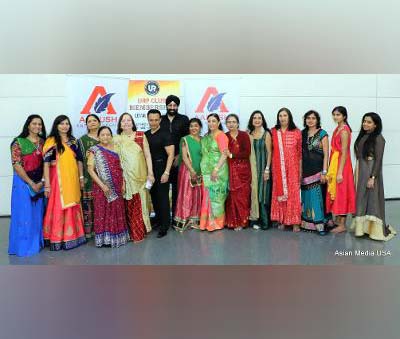 The reason people love Bharati Desai could be “because she sings from her heart and soul”, said Altaf Bukhari, Vice President Federation of Indian Associations (FIA)-Chicago IL. “The songs that she selects are well known and original folk songs” said Nisha Deshpande who was accompanied by her 3 yrs. an old son dressed up in traditional Gujarati dress, one of the many energetic participants present there. “She gives little variation in notes, but keeps the soul, the ‘atma’ of the song intact,” said Roma Bhagat. This was echoed by another very happy attendee Mrs. Priya Ghayal who described the events as an excellent, enjoyable, exceptional event presented by Bharti Desai.
The reason people love Bharati Desai could be “because she sings from her heart and soul”, said Altaf Bukhari, Vice President Federation of Indian Associations (FIA)-Chicago IL. “The songs that she selects are well known and original folk songs” said Nisha Deshpande who was accompanied by her 3 yrs. an old son dressed up in traditional Gujarati dress, one of the many energetic participants present there. “She gives little variation in notes, but keeps the soul, the ‘atma’ of the song intact,” said Roma Bhagat. This was echoed by another very happy attendee Mrs. Priya Ghayal who described the events as an excellent, enjoyable, exceptional event presented by Bharti Desai. A Certificate of Appreciation was presented Brad Seymore, President, Windy City Bulls, to Team FIA – Chicago for their participation and celebrating five years of Indian Heritage Night. The honor was received by Sunil Shah, Rita Shah, Hitesh Gandhi, Onkar Sangha, Neil Khot, Vinita Gulabani, Altaf Bukhari, Richa Chand on behalf of Team FIA. When asked, Chairman Shah said, “We promote & motivate our youth to participate & perform during the Bulls games.” President Gandhi added, “ We strive for a culture, rich & diverse, and this is one of the ways we can do it.”
A Certificate of Appreciation was presented Brad Seymore, President, Windy City Bulls, to Team FIA – Chicago for their participation and celebrating five years of Indian Heritage Night. The honor was received by Sunil Shah, Rita Shah, Hitesh Gandhi, Onkar Sangha, Neil Khot, Vinita Gulabani, Altaf Bukhari, Richa Chand on behalf of Team FIA. When asked, Chairman Shah said, “We promote & motivate our youth to participate & perform during the Bulls games.” President Gandhi added, “ We strive for a culture, rich & diverse, and this is one of the ways we can do it.” During the quarter breaks, there was a sensational Garbha folk dance by Magic Feet group ( Performers: Mahi Jain, Agalya Saminathan, Suriya Soni, Ridhima Singh, Apurva Vinodkumar, Riva Rithesh, Ahana Charanpahari ) There was also a beautiful Indian fusion dance performance by the Dancing Diamonds group. (Performers: Anika Sharma, Samiksha Joshi, Saanvi Gubba, Niyati Parashar, Urvi Chirapu, Charisma ) Team FIA presented a Certificate of Appreciation to all the performers. The program coordinators were Richa Chand (FIA -Chicago) & Logan Robben (Windy City Bulls). Other FIA members who attended and supported the event were Abir Maru, Neelam Jai, Harry Sidhu, Pratik Deshpande, Vibha Rajput, Dr Afroz Hafeez, Subbu Iyyer, Julie Thakkar, Hemendra Shah, Peenal Shah, Chandni Kalra, Kavita Rawla, Aparna Khot, Chandini Duvuri, Deepa Sharma, Dr Ramesh Nair, Manoj Rathod and Suresh Bodiwala and their friends and families.
During the quarter breaks, there was a sensational Garbha folk dance by Magic Feet group ( Performers: Mahi Jain, Agalya Saminathan, Suriya Soni, Ridhima Singh, Apurva Vinodkumar, Riva Rithesh, Ahana Charanpahari ) There was also a beautiful Indian fusion dance performance by the Dancing Diamonds group. (Performers: Anika Sharma, Samiksha Joshi, Saanvi Gubba, Niyati Parashar, Urvi Chirapu, Charisma ) Team FIA presented a Certificate of Appreciation to all the performers. The program coordinators were Richa Chand (FIA -Chicago) & Logan Robben (Windy City Bulls). Other FIA members who attended and supported the event were Abir Maru, Neelam Jai, Harry Sidhu, Pratik Deshpande, Vibha Rajput, Dr Afroz Hafeez, Subbu Iyyer, Julie Thakkar, Hemendra Shah, Peenal Shah, Chandni Kalra, Kavita Rawla, Aparna Khot, Chandini Duvuri, Deepa Sharma, Dr Ramesh Nair, Manoj Rathod and Suresh Bodiwala and their friends and families.  One of the website’s central features is its promotion of Biden’s “test-to-treat” program, which is designed to improve access to
One of the website’s central features is its promotion of Biden’s “test-to-treat” program, which is designed to improve access to 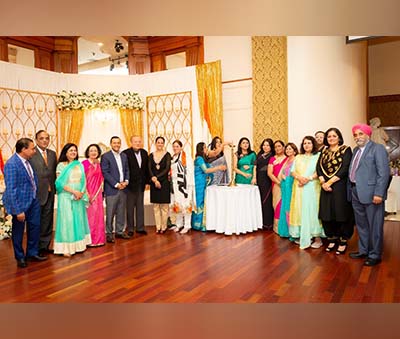 Program started with Ganesh Vandana sung by Vandana Jauhar, Dance performances presented by students of Nartan Rang Dance Academy, well-known Choreographers Swati Vaishnav and Mukthambar Fine Arts Inc., Tribute paid to Late Lata Mangeshkar Jee by Sunita Sadhnani. Chanbir Kaur Sethi, Roopam Maini, Inesha Singh, Rohini Singh and Dr Prachi Dua, Dr Pallavi Manvar Singh and Mrs Ratna Bhalla, coordinated a brief Q&A session with the honorees discussing and emphasizing their accomplishments.
Program started with Ganesh Vandana sung by Vandana Jauhar, Dance performances presented by students of Nartan Rang Dance Academy, well-known Choreographers Swati Vaishnav and Mukthambar Fine Arts Inc., Tribute paid to Late Lata Mangeshkar Jee by Sunita Sadhnani. Chanbir Kaur Sethi, Roopam Maini, Inesha Singh, Rohini Singh and Dr Prachi Dua, Dr Pallavi Manvar Singh and Mrs Ratna Bhalla, coordinated a brief Q&A session with the honorees discussing and emphasizing their accomplishments.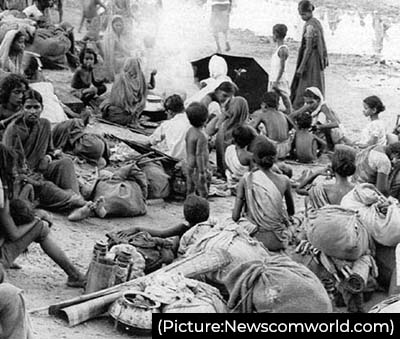 “HinduPACT has been reaching out to the lawmakers over the course of many months to inform them of this atrocity and push for a formal recognition of this genocide,” said Ajay Shah, President of World Hindu Council of America (VHPA) and the Convenor of HinduPACT. He added, “this is the largest genocide to take place in recent times. It is incomprehensible why the perpetrators of this monstrosity have not been held accountable. Are political considerations more important than justice for the victims?”
“HinduPACT has been reaching out to the lawmakers over the course of many months to inform them of this atrocity and push for a formal recognition of this genocide,” said Ajay Shah, President of World Hindu Council of America (VHPA) and the Convenor of HinduPACT. He added, “this is the largest genocide to take place in recent times. It is incomprehensible why the perpetrators of this monstrosity have not been held accountable. Are political considerations more important than justice for the victims?”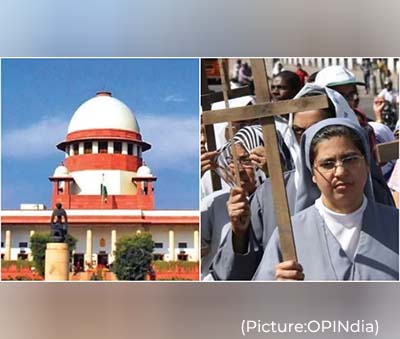 “Firstly, it is a direct violation of Article 25 of the Constitution, which guarantees every single citizen of India the fundamental right of freedom of conscience, the freedom to profess, practice and propagate one’s religion,” he said.
“Firstly, it is a direct violation of Article 25 of the Constitution, which guarantees every single citizen of India the fundamental right of freedom of conscience, the freedom to profess, practice and propagate one’s religion,” he said. Step 1: Decide which government official you want to request a resolution from and look up their contact information at
Step 1: Decide which government official you want to request a resolution from and look up their contact information at 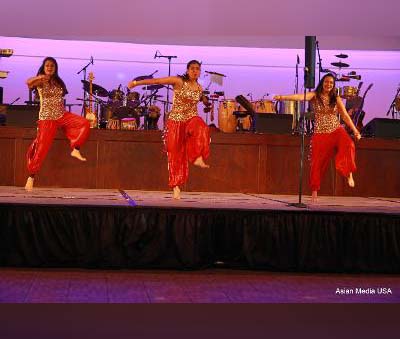 “How fitting that we can celebrate this one-of-a-kind event on our beautiful lakefront, with Mayor Lightfoot, in the city blessed by Swami Vivekananda.” Also in attendance were Consul General Amit Kumar, Indian Community Leader Niranjan S. Shah, Pratima Shah, and ABC 7 News Reporter, Ravi Baichwal.
“How fitting that we can celebrate this one-of-a-kind event on our beautiful lakefront, with Mayor Lightfoot, in the city blessed by Swami Vivekananda.” Also in attendance were Consul General Amit Kumar, Indian Community Leader Niranjan S. Shah, Pratima Shah, and ABC 7 News Reporter, Ravi Baichwal.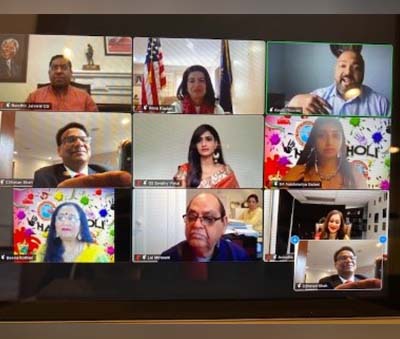 This message of unity in diversity was shared by the Chief Guest, India’s Consul General in New York, Randhirkumar Jaiswal during the annual Holi celebrations organized by GOPIO New York Chapter in collaboration with the Society of Indo-American Engineers Architects (SIAEA) in collaboration with the Consulate General of India In New York on Sunday, March 20th, 2022.
This message of unity in diversity was shared by the Chief Guest, India’s Consul General in New York, Randhirkumar Jaiswal during the annual Holi celebrations organized by GOPIO New York Chapter in collaboration with the Society of Indo-American Engineers Architects (SIAEA) in collaboration with the Consulate General of India In New York on Sunday, March 20th, 2022.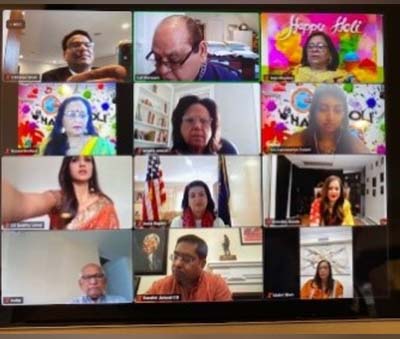 Congressman Tom Suozzi of Long Island, NY greeted the community with “Holi Mubarak” to all. Describing Holi as an exciting time for all, a great friend of India and the Indian American community, Rep. Suozzi said, “It’s great to be with you all to celebrate the festival of Holi, which reminds us of all that Spring is in the air as the flowers start blooming and we await new life and happiness. Thank you for your continued support, and I will do everything in my power to represent the Indian American community in Long Island at the US Congress and the interests of India.” Recalling his childhood as a first generation Irish American, he was taught to remember the 3 Is, Ireland, Italy, and Israel, and now, “There are for Is: Ireland, Italy, Israel and India.”
Congressman Tom Suozzi of Long Island, NY greeted the community with “Holi Mubarak” to all. Describing Holi as an exciting time for all, a great friend of India and the Indian American community, Rep. Suozzi said, “It’s great to be with you all to celebrate the festival of Holi, which reminds us of all that Spring is in the air as the flowers start blooming and we await new life and happiness. Thank you for your continued support, and I will do everything in my power to represent the Indian American community in Long Island at the US Congress and the interests of India.” Recalling his childhood as a first generation Irish American, he was taught to remember the 3 Is, Ireland, Italy, and Israel, and now, “There are for Is: Ireland, Italy, Israel and India.”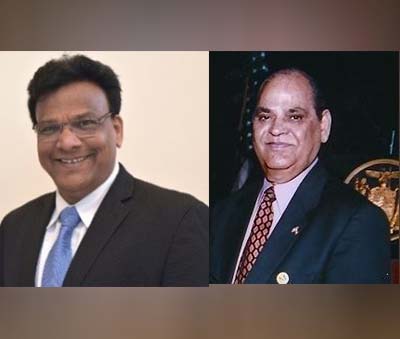 New York Senator Kevin Thomas shared with the audience how he has made it a point to bring Holi and other Indian festivals to the New York State Chambers, distributing Samosas and sweets to the members of the elected officials in Albany. He invited GOPIO to join him and other elected officials in Albany to celebrate Holi in person, after having to celebrate Holi virtually in the past 2 years due to Covid. “We hope, this is the last of all virtual celebrations,” he said, and hoped that “From now on, we can celebrate the festivities in person, meeting one another, joining our hands together,” he said.
New York Senator Kevin Thomas shared with the audience how he has made it a point to bring Holi and other Indian festivals to the New York State Chambers, distributing Samosas and sweets to the members of the elected officials in Albany. He invited GOPIO to join him and other elected officials in Albany to celebrate Holi in person, after having to celebrate Holi virtually in the past 2 years due to Covid. “We hope, this is the last of all virtual celebrations,” he said, and hoped that “From now on, we can celebrate the festivities in person, meeting one another, joining our hands together,” he said. Lal Motwani, Chairman of GOPIO New York and Executive Trustee of GOPIO International, and former president of the SIAEA, in his address, greeted Honorable India’s Consul General of New York, RandhirKumar Jaiswal and officials, members and the leaders of GOPIO from around the world who have joined virtually to celebrate the colorful festival of Holi.
Lal Motwani, Chairman of GOPIO New York and Executive Trustee of GOPIO International, and former president of the SIAEA, in his address, greeted Honorable India’s Consul General of New York, RandhirKumar Jaiswal and officials, members and the leaders of GOPIO from around the world who have joined virtually to celebrate the colorful festival of Holi. Ketan Shah, President of SIAEA served as co-emcee and introduced the speakers, executive team of GOPIO and SIAEA boards at the event and thanked the several sponsors who made the event successful by their financial support. Major sponsors among all are ICC (Grand Sponsor), Monpat Construction and Nadiad Construction (GOLD Sponsors), Amil Patel, SIAEA president-elect, Gary Wowk Founder of K Construction, Bina Sabapathy, Navneet Kothari, Dhiraj Ahuja were among the SILVER sponsors. Swathi and Aaishwariya Gulani, Miss India USA 2020 were master emcees who gracefully presented the cultural part of the program. Dharmatma Saran of the Miss India Worldwide Pageants coordinated the cultural extravaganza. Dr. Thomas Abraham, Chairman of GOPIO International in his greetings to the community on the occasion of Holi, complemented GOPIO New York and SIAEA for hosting the Holi celebrations.
Ketan Shah, President of SIAEA served as co-emcee and introduced the speakers, executive team of GOPIO and SIAEA boards at the event and thanked the several sponsors who made the event successful by their financial support. Major sponsors among all are ICC (Grand Sponsor), Monpat Construction and Nadiad Construction (GOLD Sponsors), Amil Patel, SIAEA president-elect, Gary Wowk Founder of K Construction, Bina Sabapathy, Navneet Kothari, Dhiraj Ahuja were among the SILVER sponsors. Swathi and Aaishwariya Gulani, Miss India USA 2020 were master emcees who gracefully presented the cultural part of the program. Dharmatma Saran of the Miss India Worldwide Pageants coordinated the cultural extravaganza. Dr. Thomas Abraham, Chairman of GOPIO International in his greetings to the community on the occasion of Holi, complemented GOPIO New York and SIAEA for hosting the Holi celebrations. Second-generation Indian Americans, including a 16-yr old Aditi shared with the audience their perspectives, experiences of celebrating Holi and what it meant for them. A beautiful Hindi poem on Holi composed and narrated by Anju and Sneha Singhi, a young artist was appreciated by one and all. Members of the dance troupe led by Staya Narayn Charka of the Ananda Ashram performed Kathakali, reliving the stories from the Indian Epic, Mahabharat. Navya Paingoal, Renu Kundem, and Michelle Sadat a fine vocalist also delighted the event with their beautiful singing.
Second-generation Indian Americans, including a 16-yr old Aditi shared with the audience their perspectives, experiences of celebrating Holi and what it meant for them. A beautiful Hindi poem on Holi composed and narrated by Anju and Sneha Singhi, a young artist was appreciated by one and all. Members of the dance troupe led by Staya Narayn Charka of the Ananda Ashram performed Kathakali, reliving the stories from the Indian Epic, Mahabharat. Navya Paingoal, Renu Kundem, and Michelle Sadat a fine vocalist also delighted the event with their beautiful singing. Miss Teen India Sidhya Ganesh from the state of Washington delighted the audience with a live Holi Dance. The Chander family consisting of Anil, Harish, Gopi Arti Raj presented a Bollywood Medley, mesmerizing the audience with their beautiful voice singing some of the very popular numbers from the evergreen Hindi movies. Dinesh Mirchandani, a founder, and CEO of Sargam Music Academy delighted the occasion with his classical vocal singing.
Miss Teen India Sidhya Ganesh from the state of Washington delighted the audience with a live Holi Dance. The Chander family consisting of Anil, Harish, Gopi Arti Raj presented a Bollywood Medley, mesmerizing the audience with their beautiful voice singing some of the very popular numbers from the evergreen Hindi movies. Dinesh Mirchandani, a founder, and CEO of Sargam Music Academy delighted the occasion with his classical vocal singing.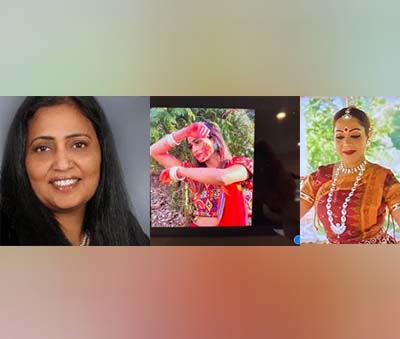 Beena Kothari, a prominent community leader and GOPIO – NY President poetically described the importance of Holi and served as an emcee of the event. Holi has become known as India’s most vivid,
Beena Kothari, a prominent community leader and GOPIO – NY President poetically described the importance of Holi and served as an emcee of the event. Holi has become known as India’s most vivid, 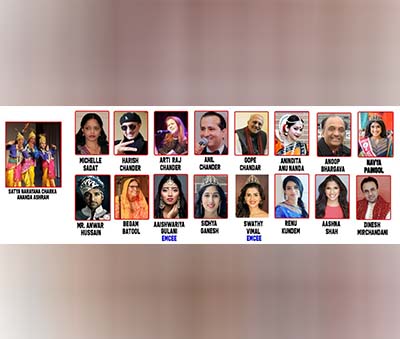 Participants, Viewers, Sponsors, and executive committees of both GOPIO-NY and SIAEA.
Participants, Viewers, Sponsors, and executive committees of both GOPIO-NY and SIAEA.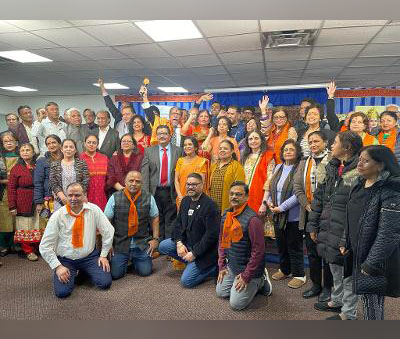 Addressing a large gathering chanting Bharat Mata ji Jai and Jai Shri Ram in New York Jagdish Sewhani President of The American India Public Affairs Committee and the Organizer of the BJP Victory Celebrations in New York thanked the voters of UP and other states for bringing back BJP in power in four states .This shows that today’s voter is smart , intelligent. They have totally rejected the politics of Dynasty and policy of appeasement corruption and voted for development, better Law and order.
Addressing a large gathering chanting Bharat Mata ji Jai and Jai Shri Ram in New York Jagdish Sewhani President of The American India Public Affairs Committee and the Organizer of the BJP Victory Celebrations in New York thanked the voters of UP and other states for bringing back BJP in power in four states .This shows that today’s voter is smart , intelligent. They have totally rejected the politics of Dynasty and policy of appeasement corruption and voted for development, better Law and order.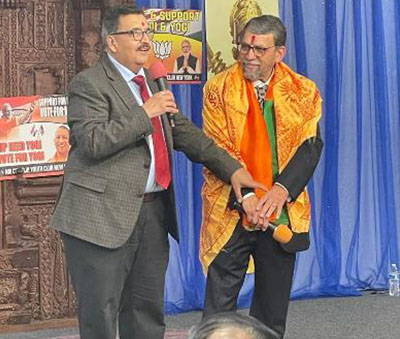 More than 100 million Farmers have benefited from PM Kisan yojana , , 89 million housewives benefited from PM Ujwala yojana and received free gas cylinders, millions of families got free Rashan under PM Garib Kalyan Yojana and more than 1.8 billion Vaccines shots were given said Sewhani. He thanked Prime Minister Modi for safely bringing back thousand of students from Ukraine. Narendra Modi is the world’s most popular leader. Today world is looking at Prime Minister Narendra Modi for solution and end war between Russia and Ukraine, said Mr Sewhani .
More than 100 million Farmers have benefited from PM Kisan yojana , , 89 million housewives benefited from PM Ujwala yojana and received free gas cylinders, millions of families got free Rashan under PM Garib Kalyan Yojana and more than 1.8 billion Vaccines shots were given said Sewhani. He thanked Prime Minister Modi for safely bringing back thousand of students from Ukraine. Narendra Modi is the world’s most popular leader. Today world is looking at Prime Minister Narendra Modi for solution and end war between Russia and Ukraine, said Mr Sewhani .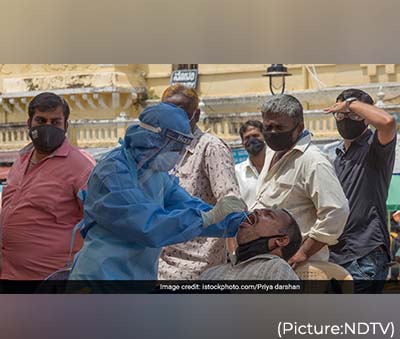 Using data from the civil registration system data for 12 states, and the mean reported deaths during the relevant periods in 2018 and 2019, the report obtained excess mortality estimates for select periods during the first and second waves. It also calculated a country-level residual using the residual from the 12 states.
Using data from the civil registration system data for 12 states, and the mean reported deaths during the relevant periods in 2018 and 2019, the report obtained excess mortality estimates for select periods during the first and second waves. It also calculated a country-level residual using the residual from the 12 states. Speaker Deepthi Suri provided very valuable information and great insight on the benefits of Ayurveda in our daily lives. Several fun filled activities were meticulously planned and executed to create a joyful atmosphere in the event that were thoroughly enjoyed by all the ladies after 2 years of pandemic situation. Special games like selfie Lele, Bomma blockbuster and Naari Shakthi by co-chairs engaged and entertained everyone.
Speaker Deepthi Suri provided very valuable information and great insight on the benefits of Ayurveda in our daily lives. Several fun filled activities were meticulously planned and executed to create a joyful atmosphere in the event that were thoroughly enjoyed by all the ladies after 2 years of pandemic situation. Special games like selfie Lele, Bomma blockbuster and Naari Shakthi by co-chairs engaged and entertained everyone. The delegation from GOPIO-CT consisted of GOPIO Intl. Chairman Dr. Thomas Abraham, GOPIO-CT President and serial investor Ashok Nichani, GOPIO-CT Exec. VP Prasad Chintalapudi who is also Vice President of IT Company Panzer Solutions, Laser Systems President Viresh Sharma, GOPIO-CT Secretary Prachi Narayan, GOPIO-CT Treasurer and IT Consultant Srinivas Akarapu, IT Consultant Mahesh Jhangiani along with his wife Yashasvi Jhangiani and Fr. Sudhir D’Souza who us the pastor of St. Philip Catholic Church in Norwalk.
The delegation from GOPIO-CT consisted of GOPIO Intl. Chairman Dr. Thomas Abraham, GOPIO-CT President and serial investor Ashok Nichani, GOPIO-CT Exec. VP Prasad Chintalapudi who is also Vice President of IT Company Panzer Solutions, Laser Systems President Viresh Sharma, GOPIO-CT Secretary Prachi Narayan, GOPIO-CT Treasurer and IT Consultant Srinivas Akarapu, IT Consultant Mahesh Jhangiani along with his wife Yashasvi Jhangiani and Fr. Sudhir D’Souza who us the pastor of St. Philip Catholic Church in Norwalk.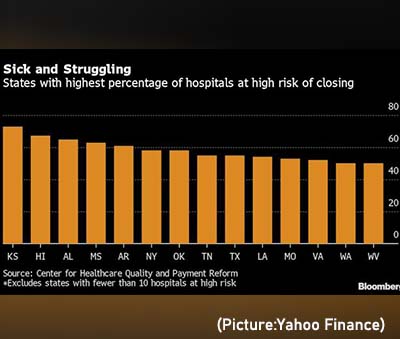 “The myth is that these are hospitals that should no longer exist in communities that should no longer exist,” Miller said in an interview. Keeping those facilities open would cost $3.4 billion, or less than 1% of total annual spending on hospitals, said Miller, an adjunct public policy and management
“The myth is that these are hospitals that should no longer exist in communities that should no longer exist,” Miller said in an interview. Keeping those facilities open would cost $3.4 billion, or less than 1% of total annual spending on hospitals, said Miller, an adjunct public policy and management 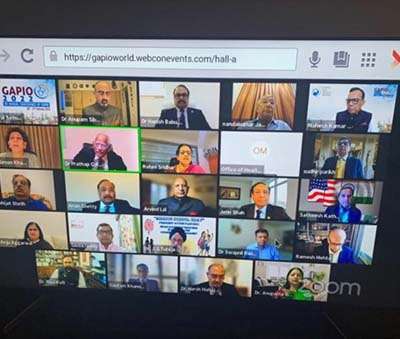 Dr. Prathap C. Reddy, founder and president of GAPIO, and chairman of Apollo Hospitals Group was the Guest of Honor. A non-profit organization, GAPIO is a leading association for the Indian medical diaspora and the annual conference has become an important event in the medical calendar for physicians and other medical personnel around the globe.
Dr. Prathap C. Reddy, founder and president of GAPIO, and chairman of Apollo Hospitals Group was the Guest of Honor. A non-profit organization, GAPIO is a leading association for the Indian medical diaspora and the annual conference has become an important event in the medical calendar for physicians and other medical personnel around the globe. At the beginning of the meeting, GOPIO Chairman Dr. Abraham thanked Mayor Adams for appointing many Indian Americans in high position of the city administration. In addition to the issue of defacing of Mahatma Gandhi statue, many other issues were discussed at this power meeting of the City officials with the community. The community representatives urged the mayor to keep status que on
At the beginning of the meeting, GOPIO Chairman Dr. Abraham thanked Mayor Adams for appointing many Indian Americans in high position of the city administration. In addition to the issue of defacing of Mahatma Gandhi statue, many other issues were discussed at this power meeting of the City officials with the community. The community representatives urged the mayor to keep status que on 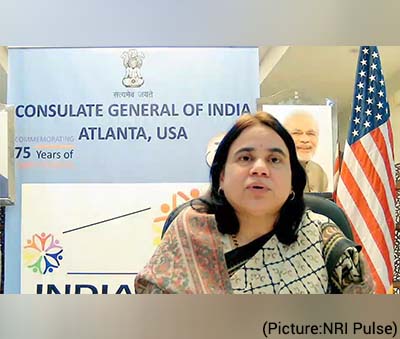 Community leaders during the meeting appreciated India’s efforts, but also raised questions and concerns including why India has yet to take a firm position on the Ukraine issue. They raised questions around India’s decision to abstain from voting at the United Nations Security Council (UNSC), lack of initiating a mandatory evacuation of its citizens prior to the start of the war, discrimination and harassment faced by Indian students at Ukraine’s borders citing media reports and social media posts, role of community leaders in assisting India respond to the crisis, India’s role in de-escalating tensions between Russia and Ukraine, and how to respond to members of US Congress and local US officials about India’s stand on the issue of Ukraine. Community leaders have also requested Dr. Kulkarni to convey their concerns to the Indian Government to ensure the protection of Indian citizens.
Community leaders during the meeting appreciated India’s efforts, but also raised questions and concerns including why India has yet to take a firm position on the Ukraine issue. They raised questions around India’s decision to abstain from voting at the United Nations Security Council (UNSC), lack of initiating a mandatory evacuation of its citizens prior to the start of the war, discrimination and harassment faced by Indian students at Ukraine’s borders citing media reports and social media posts, role of community leaders in assisting India respond to the crisis, India’s role in de-escalating tensions between Russia and Ukraine, and how to respond to members of US Congress and local US officials about India’s stand on the issue of Ukraine. Community leaders have also requested Dr. Kulkarni to convey their concerns to the Indian Government to ensure the protection of Indian citizens.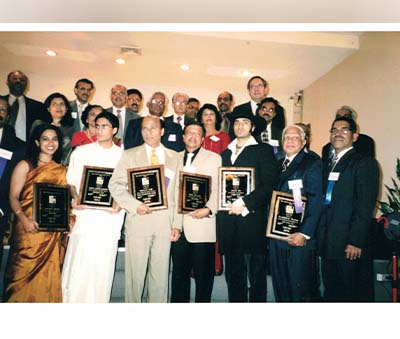 I completed my Honors and Master’s in Economics from Delhi University. Our eldest brother, Rameshwar Dayal, (RD) completed his
I completed my Honors and Master’s in Economics from Delhi University. Our eldest brother, Rameshwar Dayal, (RD) completed his  In 1955. the Ford Foundation provided financial support to start a pilot project in Urban Community Development (UCD). It was headed by Mr. Chatterjee, as Director, who had been in touch with Ford Foundation Consultant, Dr. Marshall Clinard. UCD worked in collaboration with BSS, Mr. Chatterjee asked Mr. Brij Krishan Chandiwala, BSS Convener, that he would like to hire me as a Research Associate. And he asked his opinion also about my work ethics etc. The offices of UCD and BSS were just a block apart in New Delhi.
In 1955. the Ford Foundation provided financial support to start a pilot project in Urban Community Development (UCD). It was headed by Mr. Chatterjee, as Director, who had been in touch with Ford Foundation Consultant, Dr. Marshall Clinard. UCD worked in collaboration with BSS, Mr. Chatterjee asked Mr. Brij Krishan Chandiwala, BSS Convener, that he would like to hire me as a Research Associate. And he asked his opinion also about my work ethics etc. The offices of UCD and BSS were just a block apart in New Delhi. Since the UCD office was in Connaught Place, almost all those who worked for the survey of slums of Delhi remained in touch with one another. During evening they all (about ten) used to meet in Cannaught Place and sit on the lawn as we had no office. I was always there and led the group. We always thought of doing something productive as all of us were fully employed.
Since the UCD office was in Connaught Place, almost all those who worked for the survey of slums of Delhi remained in touch with one another. During evening they all (about ten) used to meet in Cannaught Place and sit on the lawn as we had no office. I was always there and led the group. We always thought of doing something productive as all of us were fully employed. Around 2004-05, my wife was suspected to have Alzheimer’s which was later ruled out. However, she started signs of weakness, forgetfulness and it was not possible to leave her home alone. With the help from various agencies in home care and other areas we were able to carry on for about five years or so. My wife and I knew about Shantiniketan (SN) in Tavares, Florida. Around the same time My oldest daughter Monica and her husband, Madan Gupta, were in Orlando related to their business. On my request they visited SN.
Around 2004-05, my wife was suspected to have Alzheimer’s which was later ruled out. However, she started signs of weakness, forgetfulness and it was not possible to leave her home alone. With the help from various agencies in home care and other areas we were able to carry on for about five years or so. My wife and I knew about Shantiniketan (SN) in Tavares, Florida. Around the same time My oldest daughter Monica and her husband, Madan Gupta, were in Orlando related to their business. On my request they visited SN.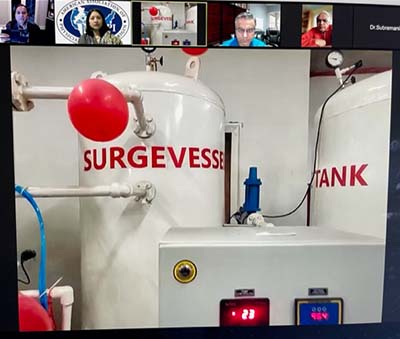 “The generosity of the members of AAPI has been unprecedented,” says Dr. Anupama Gotimukula, President of AAPI. “I want to thank the AAPI fraternity, for not only contributing $5.5 Million towards Covid Relief Funds for India, but has spent hundreds of hours in coordinating and disbursing the vital medical supplies to the most needed hospitals across India.”
“The generosity of the members of AAPI has been unprecedented,” says Dr. Anupama Gotimukula, President of AAPI. “I want to thank the AAPI fraternity, for not only contributing $5.5 Million towards Covid Relief Funds for India, but has spent hundreds of hours in coordinating and disbursing the vital medical supplies to the most needed hospitals across India.”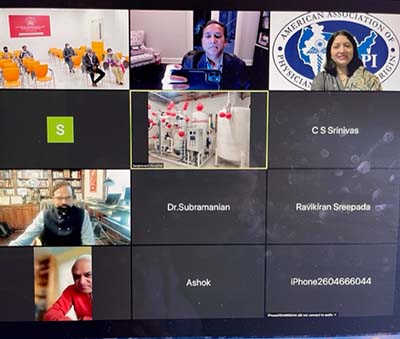 “We continue to coordinate efforts to make available the much needed vaccines in the Slum areas in major cities where compliance is very low and apart from life-saving equipment for severe Covid patients management in ICUs,” said Dr. Tarak Vasavada, who has been in the forefront leading AAPI’s efforts to help India during the Covid.
“We continue to coordinate efforts to make available the much needed vaccines in the Slum areas in major cities where compliance is very low and apart from life-saving equipment for severe Covid patients management in ICUs,” said Dr. Tarak Vasavada, who has been in the forefront leading AAPI’s efforts to help India during the Covid. “AAPI has sent more than 2300 oxygen concentrators, 100 ventilators, 200 high flow oxygen devices since 2021 to various parts of India. We are working to help AIIMS across the country which have been opened recently that haven’t secured the full funding yet from the government. After our initial donation to AIIMS, Bibinagar, Telangana AAPI is planning to donate immunoanlysers to all AIIMS across the country. As you may remember, AAPI had donated ventilators and high flow oxygen equipment to AIIMS in the past,” Dr. Satheesh Kathula, Clinical Professor of Medicine and AAPI Secretary said.
“AAPI has sent more than 2300 oxygen concentrators, 100 ventilators, 200 high flow oxygen devices since 2021 to various parts of India. We are working to help AIIMS across the country which have been opened recently that haven’t secured the full funding yet from the government. After our initial donation to AIIMS, Bibinagar, Telangana AAPI is planning to donate immunoanlysers to all AIIMS across the country. As you may remember, AAPI had donated ventilators and high flow oxygen equipment to AIIMS in the past,” Dr. Satheesh Kathula, Clinical Professor of Medicine and AAPI Secretary said.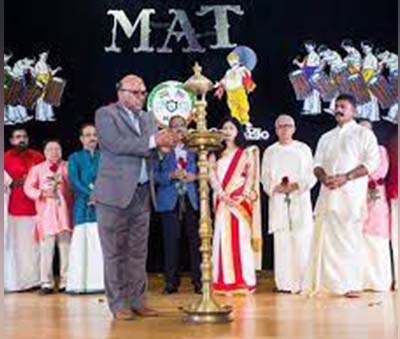 Madhavan B Nair was born and raised in Neyyattinkara, located to the south of capital city Trivandrum of Kerala State. He is from Thalakulam Kunnakode family and born to Rajyasree Bhaskara Pillai and Rugmini Amma. His father Rajyasree Bhaskara Pillai was a freedom fighter, Editor and Publisher of Rajyasree Newspaper during that period. He completed his Primary, Middle and Higher Secondary schooling from Government School, Neyyattinkara; St. Mary’s School, Pattom and Government High School, Kattathurai respectively.
Madhavan B Nair was born and raised in Neyyattinkara, located to the south of capital city Trivandrum of Kerala State. He is from Thalakulam Kunnakode family and born to Rajyasree Bhaskara Pillai and Rugmini Amma. His father Rajyasree Bhaskara Pillai was a freedom fighter, Editor and Publisher of Rajyasree Newspaper during that period. He completed his Primary, Middle and Higher Secondary schooling from Government School, Neyyattinkara; St. Mary’s School, Pattom and Government High School, Kattathurai respectively. The festival of Lohri holds great significance as it marks the harvest of the rabi crops and the end of winter days. In Northern India, Lohri is usually celebrated with a bonfire. The lighting of a bonfire during this festival is an old tradition. Ancient people lit the bonfire to welcome the return of longer days.
The festival of Lohri holds great significance as it marks the harvest of the rabi crops and the end of winter days. In Northern India, Lohri is usually celebrated with a bonfire. The lighting of a bonfire during this festival is an old tradition. Ancient people lit the bonfire to welcome the return of longer days. After more than a decade on the South Asian music scene she was honored to receive the ‘Special Contribution Award’ at the UK Bhangra Awards, 2019. She also won her Global Music Award ,2021 for Best Female Vocalist for her latest solo album “Love is my Religion”.
After more than a decade on the South Asian music scene she was honored to receive the ‘Special Contribution Award’ at the UK Bhangra Awards, 2019. She also won her Global Music Award ,2021 for Best Female Vocalist for her latest solo album “Love is my Religion”. Members celebrating their birthday in January and February were congratulated on their special days. Some members were also presented with awards for their excellent community service and leadership qualities. Award winning members included Ashwin Majumdar, Suresh Amin, Haribhai Lilabem Thakkar, Pinky Thakkar, Aruna Patel and Dilip Patel. Awards were presented by Arvind Patel.
Members celebrating their birthday in January and February were congratulated on their special days. Some members were also presented with awards for their excellent community service and leadership qualities. Award winning members included Ashwin Majumdar, Suresh Amin, Haribhai Lilabem Thakkar, Pinky Thakkar, Aruna Patel and Dilip Patel. Awards were presented by Arvind Patel.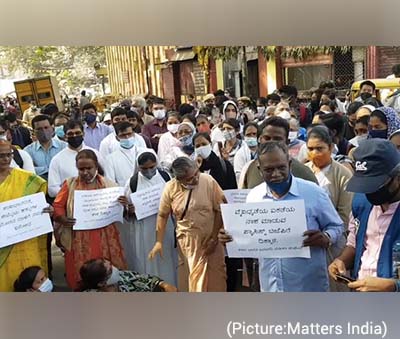 While articulating that that a new Anti-Conversion Law is not necessary since the Indian Constitution has enough provisions for the same, the signatories also stated: `Wherever the Anti-Conversion law, ironically officially called Freedom of Religion Act, was passed, it became a justification for the persecution of the minorities and other marginalized identities. The attacks on the minorities grew sharply in recent years since this law was used as a weapon targeting the dignity of Christians and Muslims particularly belonging to Adivais, Dalits and women.’ The petition called for joining hands to defend the values enshrined in the Indian Constitution and protection of human rights of the minorities and other marginalized sections in India. The petition was initiated by the National Solidarity Forum, a network of groups and individuals who started acting in response to the Kandhamal Genocide on the Adivasi Christians and Dalit Christians in 2007-2008.
While articulating that that a new Anti-Conversion Law is not necessary since the Indian Constitution has enough provisions for the same, the signatories also stated: `Wherever the Anti-Conversion law, ironically officially called Freedom of Religion Act, was passed, it became a justification for the persecution of the minorities and other marginalized identities. The attacks on the minorities grew sharply in recent years since this law was used as a weapon targeting the dignity of Christians and Muslims particularly belonging to Adivais, Dalits and women.’ The petition called for joining hands to defend the values enshrined in the Indian Constitution and protection of human rights of the minorities and other marginalized sections in India. The petition was initiated by the National Solidarity Forum, a network of groups and individuals who started acting in response to the Kandhamal Genocide on the Adivasi Christians and Dalit Christians in 2007-2008.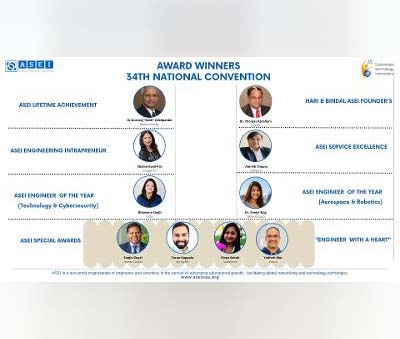 The award ceremony for this convention will end with a finale awards ceremony session on Feb27 at 10 am (PST). where 10 outstanding achievers and those who contributed to ASEI growth and the society at large will be honored in addition to student winners of the YTE competition. This year’s outstanding achievement awards go to the following:
The award ceremony for this convention will end with a finale awards ceremony session on Feb27 at 10 am (PST). where 10 outstanding achievers and those who contributed to ASEI growth and the society at large will be honored in addition to student winners of the YTE competition. This year’s outstanding achievement awards go to the following: This was perhaps the third most violent Christmas the community has faced in India. On Christmas eve of 1998, 36 rural log churches were burnt and destroyed in the Dangs forested district of the state of Gujarat. The incidents were dubbed a “laboratory for right wing religious and nationalist fanatics.” On Christmas eve of 2007, another forest district, this time Kandhamal in the state of Orissa [now called Odisha] became the laboratory. Villages, houses, small prayer halls, large churches, and institutions were burnt, and people forced to flee for their lives into the forest. The violence was repeated a few months later. More than 100 were killed, many women, including a Catholic Nun raped, and close to 400 Churches and institutions destroyed. The Orissa government had identified the attackers as belonging to an arm of the Rashtriya Swayamsewak Sangh which had launched a massive hate campaign targeting the Christian community.
This was perhaps the third most violent Christmas the community has faced in India. On Christmas eve of 1998, 36 rural log churches were burnt and destroyed in the Dangs forested district of the state of Gujarat. The incidents were dubbed a “laboratory for right wing religious and nationalist fanatics.” On Christmas eve of 2007, another forest district, this time Kandhamal in the state of Orissa [now called Odisha] became the laboratory. Villages, houses, small prayer halls, large churches, and institutions were burnt, and people forced to flee for their lives into the forest. The violence was repeated a few months later. More than 100 were killed, many women, including a Catholic Nun raped, and close to 400 Churches and institutions destroyed. The Orissa government had identified the attackers as belonging to an arm of the Rashtriya Swayamsewak Sangh which had launched a massive hate campaign targeting the Christian community. During the colonial period, divisive tendencies in the name of religion reared their head due to the British policy of divide and rule. The elite sections of society initiated and encouraged these tendencies. However, they were overshadowed by the integrative and all-inclusive freedom movement. It is here that the magical interpretation of Hinduism by Gandhi succeeded in mobilising people of all religions within the single thread of Indian nationalism. The charisma of Gandhi’s movements left a deep impression on people of all faiths. People recited shlokas from the Gita and verses from the Koran and the Bible in his prayer meetings.
During the colonial period, divisive tendencies in the name of religion reared their head due to the British policy of divide and rule. The elite sections of society initiated and encouraged these tendencies. However, they were overshadowed by the integrative and all-inclusive freedom movement. It is here that the magical interpretation of Hinduism by Gandhi succeeded in mobilising people of all religions within the single thread of Indian nationalism. The charisma of Gandhi’s movements left a deep impression on people of all faiths. People recited shlokas from the Gita and verses from the Koran and the Bible in his prayer meetings. Living on the moon panel explored getting most efficiently and cheaply to the Moon not only for tourism, but to establish settlements on the Moon, to live and work there. This time, it will be mining for the most important, life sustaining water-ice on the Moon, as well as exploring the lava tubes for habitats. Moderated by Dr. David Livingston, the knowledgeable expert panelists Dr. Bhavya Lal, Prof. Haym Benoroya and Dr. Ajay Kothari shared their vision
Living on the moon panel explored getting most efficiently and cheaply to the Moon not only for tourism, but to establish settlements on the Moon, to live and work there. This time, it will be mining for the most important, life sustaining water-ice on the Moon, as well as exploring the lava tubes for habitats. Moderated by Dr. David Livingston, the knowledgeable expert panelists Dr. Bhavya Lal, Prof. Haym Benoroya and Dr. Ajay Kothari shared their vision Veteran philanthropist and venture capitalist MR Rangaswami captivated the audience with his whirlwind tour of 40 years’ journey of Indian engineers from the trenches to the corner office in the US. Citing numerous success stories from his chapter in the book “Kamala Harris and the rise of Indian Americans”, he engaged with audience questions as well.
Veteran philanthropist and venture capitalist MR Rangaswami captivated the audience with his whirlwind tour of 40 years’ journey of Indian engineers from the trenches to the corner office in the US. Citing numerous success stories from his chapter in the book “Kamala Harris and the rise of Indian Americans”, he engaged with audience questions as well. The attendees also included Commissioner Sue Kylie who is running for Congress, and Township office holders, elected officials, representatives from the Police Department and the Department of Defense. Among other guests were heads of several community organizations, sponsors of the event and donors.
The attendees also included Commissioner Sue Kylie who is running for Congress, and Township office holders, elected officials, representatives from the Police Department and the Department of Defense. Among other guests were heads of several community organizations, sponsors of the event and donors. Speaking to those gathered, Dr. Sunil Parikh said he was very proud to see IACONA take a big step towards creating more awareness about India by celebrating India’s Republic Day. He said the SSAI had been working in New Jersey and in India for the past 21 months, providing meals, masks, plasma, navigation help for COVID testing and for vaccination. The organization was planning a new Health Center in partnership with St. Peters Hospital, he said.
Speaking to those gathered, Dr. Sunil Parikh said he was very proud to see IACONA take a big step towards creating more awareness about India by celebrating India’s Republic Day. He said the SSAI had been working in New Jersey and in India for the past 21 months, providing meals, masks, plasma, navigation help for COVID testing and for vaccination. The organization was planning a new Health Center in partnership with St. Peters Hospital, he said.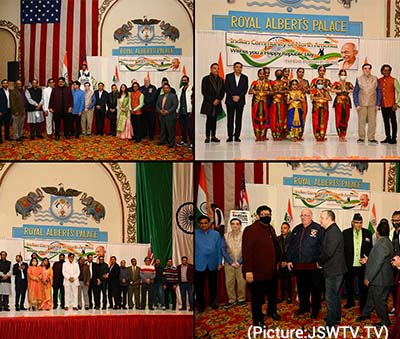 The Federation of Indian Associations Ohio held a Flag Hoisting ceremony at the Ohio State House in Columbus, Ohio, on January 26. Ohio State Senator Niraj Antani and prominent members of the Indian community were present at the event. The program was live-streamed.
The Federation of Indian Associations Ohio held a Flag Hoisting ceremony at the Ohio State House in Columbus, Ohio, on January 26. Ohio State Senator Niraj Antani and prominent members of the Indian community were present at the event. The program was live-streamed.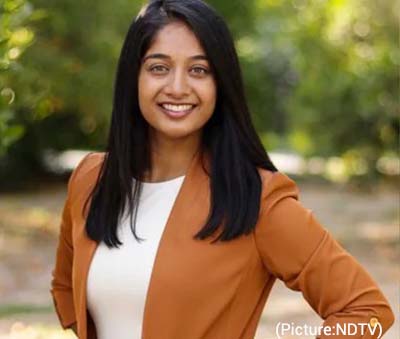 “Our team is extremely honored to endorse Nida Allam and Kesha Ram Hinsdale for Congress. Both Nida and Kesha uphold the progressive and justice-oriented values that we at IMPACT are thrilled to support in tandem,” Makhija said.
“Our team is extremely honored to endorse Nida Allam and Kesha Ram Hinsdale for Congress. Both Nida and Kesha uphold the progressive and justice-oriented values that we at IMPACT are thrilled to support in tandem,” Makhija said.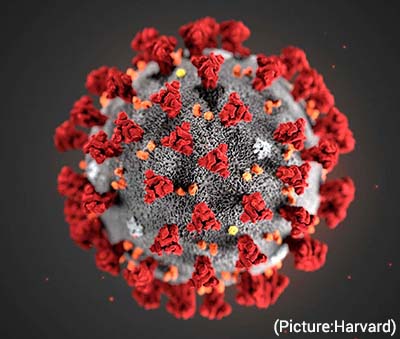 The governors had met earlier with
The governors had met earlier with  The researchers determined that low SES patients—who more commonly received health care under government payor programs such as Medicare and Medicaid (63% vs. 49%)—had more urgent/emergent surgery (21% vs. 13%), with minimally-invasive approaches used less often (24% vs. 39%).
The researchers determined that low SES patients—who more commonly received health care under government payor programs such as Medicare and Medicaid (63% vs. 49%)—had more urgent/emergent surgery (21% vs. 13%), with minimally-invasive approaches used less often (24% vs. 39%). In his inaugural address, Indian Consul General Randhir Kumar Jaiswal, a career diplomat with over two decades of diplomatic career serving in Portugal, Cuba, South Africa and at the Permanent Mission of India in New York, greeted the Diaspora in the United States and around the world on the occasion of India’s 73rd Republic Day celebrations.
In his inaugural address, Indian Consul General Randhir Kumar Jaiswal, a career diplomat with over two decades of diplomatic career serving in Portugal, Cuba, South Africa and at the Permanent Mission of India in New York, greeted the Diaspora in the United States and around the world on the occasion of India’s 73rd Republic Day celebrations. Referring to the several elected Indian American leaders who attended the event, Ambassador Jaiswal said, “Your presence and greetings mean a lot to us and to the Indian Diaspora and to the Indo-US relationship.” Announcing that India has provided 1.6 Billion does of Covid vaccination in the past 1 year, the senior diplomat representing India told the participants, how India’s economy is doing remarkably well and that there are 60,000 StartUP Companies established in the past year. He praised India’s efforts towards women’s empowerment as India continues to contribute towards world peace and prosperity.
Referring to the several elected Indian American leaders who attended the event, Ambassador Jaiswal said, “Your presence and greetings mean a lot to us and to the Indian Diaspora and to the Indo-US relationship.” Announcing that India has provided 1.6 Billion does of Covid vaccination in the past 1 year, the senior diplomat representing India told the participants, how India’s economy is doing remarkably well and that there are 60,000 StartUP Companies established in the past year. He praised India’s efforts towards women’s empowerment as India continues to contribute towards world peace and prosperity. Kesha Ram, Burlington, Vermont, VT State Senator, shared of the reasons for her entering politics. “I got engaged with the community for long, where we care for each other.” One of the youngest ever to be elected to State Assembly at the age of 21, she said, “I am the first ever woman of color top be elected to the state Assembly in Vermont. Continuing to break through the barriers, we can work together to elect more NRIs. “It’s incredible to be of public service, following in the footsteps of my great grandfathers, ” she said, referring to her ancestry back in India, who had fought for the freedom for India. “We have carried with us that spirit of community service.”
Kesha Ram, Burlington, Vermont, VT State Senator, shared of the reasons for her entering politics. “I got engaged with the community for long, where we care for each other.” One of the youngest ever to be elected to State Assembly at the age of 21, she said, “I am the first ever woman of color top be elected to the state Assembly in Vermont. Continuing to break through the barriers, we can work together to elect more NRIs. “It’s incredible to be of public service, following in the footsteps of my great grandfathers, ” she said, referring to her ancestry back in India, who had fought for the freedom for India. “We have carried with us that spirit of community service.” Dr. Jaya Daptardar eloquently emceed the event. American National Anthem was sung by: Mathy Pillai, while the Indian National Anthem was by Jyothi Gupta and team from Long Island. Popular artists from around the world, including Pallavi Belwariar , Kedar Godbole , Srinivas Gunupuru, and Trupti Shah presented popular evergreen patriotic songs such as Vande Mataram and Jai Ho with their beautiful voices. Media Sponsor and Live Streaming was provided by Indus TV (New Jersey). Shivender Sofat, President of GOPIO Manhattan, proposed vote of thanks.
Dr. Jaya Daptardar eloquently emceed the event. American National Anthem was sung by: Mathy Pillai, while the Indian National Anthem was by Jyothi Gupta and team from Long Island. Popular artists from around the world, including Pallavi Belwariar , Kedar Godbole , Srinivas Gunupuru, and Trupti Shah presented popular evergreen patriotic songs such as Vande Mataram and Jai Ho with their beautiful voices. Media Sponsor and Live Streaming was provided by Indus TV (New Jersey). Shivender Sofat, President of GOPIO Manhattan, proposed vote of thanks. They held discussion on further bolstering the strong partnership between India and the City of New York with special emphasis on key areas including affordable healthcare, renewable energy, new and emerging technology, education and knowledge partnership, IT and fintech.
They held discussion on further bolstering the strong partnership between India and the City of New York with special emphasis on key areas including affordable healthcare, renewable energy, new and emerging technology, education and knowledge partnership, IT and fintech. Congressman Raja Krishnamoorthi in his inimitable style addressed the cheering audience and expressed great joy and best wishes to Team FIA and the entire Indian community for the outstanding contributions, over more than a decade now.
Congressman Raja Krishnamoorthi in his inimitable style addressed the cheering audience and expressed great joy and best wishes to Team FIA and the entire Indian community for the outstanding contributions, over more than a decade now. Hitesh Bhatt, Founder & Kim Bhatt, President of the Bhatt Foundation were honored with a Plaque and were acknowledged for their sponsorship support to FIA. In their speech, the Bhatt’s, shared their message of “Improving Global HealthCare and Education through Innovation”. They touched upon their philanthropic work in USA / India / Honduras / Africa and expressed their interest in supporting FIA’s initiatives as well.
Hitesh Bhatt, Founder & Kim Bhatt, President of the Bhatt Foundation were honored with a Plaque and were acknowledged for their sponsorship support to FIA. In their speech, the Bhatt’s, shared their message of “Improving Global HealthCare and Education through Innovation”. They touched upon their philanthropic work in USA / India / Honduras / Africa and expressed their interest in supporting FIA’s initiatives as well.